You are using an out of date browser. It may not display this or other websites correctly.
You should upgrade or use an alternative browser.
You should upgrade or use an alternative browser.
Jialai Carat
- Added by o0genesis0o
- Create date
baskingshark
Headphoneus Supremus
Pros: Very generously accessorized
Ergonomic fit
Beautiful mirror-like housings, solidly built
Easily driven
Above average technicalities
Boosted treble would be a kindred spirit for trebleheads
Ergonomic fit
Beautiful mirror-like housings, solidly built
Easily driven
Above average technicalities
Boosted treble would be a kindred spirit for trebleheads
Cons: Shells are fingerprint and scratch magnets
Thin note weight with nasal vocals
Overly recessed lower midrange
Possibly fatiguing in the upper frequencies, not for treble-sensitive folk
Thin note weight with nasal vocals
Overly recessed lower midrange
Possibly fatiguing in the upper frequencies, not for treble-sensitive folk
DISCLAIMER
I would like to thank the NiceHCK for providing this review unit.
The Jialai Carat can be gotten here: https://www.aliexpress.com/item/1005006660245454.html (no affiliate links).

SPECIFICATIONS
ACCESSORIES
Other than the IEM, these are included:
- 3 pairs of wide-bore silicone eartips (S/M/L/)
- 3 pairs of narrow-bore silicone eartips (S/M/L)
- 3 pairs of balanced silicone eartips (S/M/L)
- Cable
- Carrying case
Other than the lack of foam tips, the provisions are very generous for a sub-$100 USD IEM. I've definitely seen pricier sets with stingier accessories.

We have 3 variations of silicone tips. The wide-bore ones boost treble and soundstage, whereas the narrow-bore ones do the opposite in increasing bass but compressing staging. The balanced ones are a midpoint between these 2 in terms of sonics.

The OFC 2-pin cable is braided decently, but has microphonics and is a bit tangly. There is a chin cinch for added grip. Not the best stock cable, but serviceable in a way.

Lastly, we have a leatherette semi-rigid case. This has a magnetic clasp, and is lined internally with velvet to cushion the contents.
The rest of this review was done with the stock cable and stock balanced silicone tips. No aftermarket accessories were used, so as not to add any confounders to the sound.
BUILD/COMFORT

Like its namesake, the Carat is gleaming and alluring, with a polished mirror-like finish. The shells are fashioned from aluminum alloy via 5-axis CNC machining, with solid build. These enchanting housings are however scratch and fingerprint magnets, so on a practical basis, it might behoof the user to baby this IEM during usage.

Comfort and ergonomics are good. The shells are light, with no awkward protrusions on the inner aspects to poke the ears. It can be used for marathon listening sessions without discomfort.
Isolation is average in view of the vented acoustics. I did not encounter any driver flex on my pair.

INTERNALS
The Carat's engine is a 10 mm titanium-plated DLC dynamic driver.
DRIVABILITY
I tested the Carat with the following sources:
- Apple dongle
- Cayin RU7
- Chord Mojo 2
- Fiio KA11 dongle
- Fiio KA17 dongle
- Khadas Tone Board -> Schiit Asgard 3 amp
- Questyle M15 DAC/AMP dongle
- Sony Walkman NW A-55 DAP (Walkman One WM1Z Plus v2 Mod)
- Sony Walkman NW A-55 DAP (Walkman One Neutral Mod)
- Sony Walkman NW WM1A DAP (Walkman One WM1Z Plus v2 Mod)
- Smartphone
This IEM is easily driven, and amplification is not 100% necessary.
SOUND & TECHNICALITIES

Graph of the Jialai Carat via IEC711 coupler. 8 kHz is a coupler peak.
Tonally, the Carat sports a bright V-shaped tuning, with an emphasis at the top-end.
The Carat has a sub-bass preponderance, with decent rumble at the low-end. It doesn't exactly hit basshead levels, but is definitely north of neutral. Mid-bass is thumpy, with above average texturing and speed. Mid-bass bleed is thankfully mild.
As per the V-shaped profile, the lower midrange is recessed, and can come across as thin. Hitting nearly 9 dB in the ear gain region, the upper mids are forwards with some nasalness and shoutiness noted, especially at louder volumes (Fletcher Munson curve).
Continuing on from the upper mids, the lower treble peaks at around the 5 - 6 kHz regions. This provides lots of clarity, but there is some sibilance and fatigue, especially if one is treble-sensitive. Trebleheads will certainly like the tuning choices though, so there are pros and cons here.
In terms of timbre, while acoustic instruments sound quite accurately portrayed, the aforementioned thin note weight does bestow sterileness to the soundscape and nasalness to vocals.
I would grade the Carat as having above average technicalities. Soundstage is not compressed but not classleading either, going to just beyond the ears. Imaging while not exactly dead pinpoint, is still fairly well-localized. Clarity is emphasized by the feisty upper end, and instrument separation is acceptable. Micro-detailing is solid for a sub-$100 single DD.
COMPARISONS
The Carat will be compared against some other budget single DDs. Hybrids, pure BAs and planars are left out of the comparisons, as the different transducer types will have their own inherent pros and cons.
Simgot EA500LM

Graphs of the EA500LM via IEC711 coupler. 8 kHz is a coupler peak.
The EA500LM has 3 tuning nozzles to vary the sonics and provide more versatility, though all tunings still lie towards a brighter Harmanish tone.
The EA500LM has a thicker note weight, with a slightly more organic timbre. In technical chops, the EA500LM has a better soundstage, with more precise imaging, though micro-detailing and clarity goes to the Carat.
Kefine Delci

Graph of the Delci via IEC711 coupler. 8 kHz is a coupler peak.
The Delci has less treble and upper mids, thus bestowing a more relaxing upper end, with less fatigue and sibilance heard.
The Delci has a more natural timbre with a thicker note weight. In technicalities, the Delci trumps the Carat in soundstage, though the Delci has weaker micro-detailing. Imaging is about on par, though the Carat has sharper edge definition to notes.
CONCLUSIONS

In a sea of weekly single DD releases, we hear a clean and bright tone in the Carat, coupled with decent technical chops and a good sprinkling of micro-detailing and clarity. Accessories are second to none at this price range, with beautiful mirror-like shells, comfortable fit and easy drivability. While the charming mirror-like shells are a looker, on a practical basis, the housings may easily get scratched or smudged.
Sound-wise, there are some tonal flaws - an overly thin lower midrange culminates in an exuberant bloom in the upper end - resulting in a sterile soundscape that is entwined with some fatigue in the upper mids and lower treble. Vocals can come across as nasal and the Carat is thus not one for the treble-sensitive. However, on the converse, trebleheads might be very at home with the tonality.
All things considered, the Carat is a diamond in the rough. This unearthed gem lies in the realm of average - it isn't an extraordinary jewel but isn't a bad set by any means. However, the competition in budget CHIFI-land is so cut-throat nowadays, that even average may sadly not be enough: next week promises a new shiny hypetrain to grab the attention of consumers! Nevertheless, for a pioneer release from the brand, the Jialai Carat is okay, and would be a potential bridgehead for further (hopefully) more refined and polished gems down the line.
I would like to thank the NiceHCK for providing this review unit.
The Jialai Carat can be gotten here: https://www.aliexpress.com/item/1005006660245454.html (no affiliate links).

SPECIFICATIONS
- Driver configuration: 10 mm titanium-plated DLC dynamic driver
- Frequency response: 10 Hz - 28 kHz
- Impedance: 32 Ω
- Sensitivity: 106 dB/mW
- Cable: 2-pin, 0.78 mm; OFC cable
- Tested at: $69 USD
ACCESSORIES
Other than the IEM, these are included:
- 3 pairs of wide-bore silicone eartips (S/M/L/)
- 3 pairs of narrow-bore silicone eartips (S/M/L)
- 3 pairs of balanced silicone eartips (S/M/L)
- Cable
- Carrying case
Other than the lack of foam tips, the provisions are very generous for a sub-$100 USD IEM. I've definitely seen pricier sets with stingier accessories.

We have 3 variations of silicone tips. The wide-bore ones boost treble and soundstage, whereas the narrow-bore ones do the opposite in increasing bass but compressing staging. The balanced ones are a midpoint between these 2 in terms of sonics.

The OFC 2-pin cable is braided decently, but has microphonics and is a bit tangly. There is a chin cinch for added grip. Not the best stock cable, but serviceable in a way.

Lastly, we have a leatherette semi-rigid case. This has a magnetic clasp, and is lined internally with velvet to cushion the contents.
The rest of this review was done with the stock cable and stock balanced silicone tips. No aftermarket accessories were used, so as not to add any confounders to the sound.
BUILD/COMFORT

Like its namesake, the Carat is gleaming and alluring, with a polished mirror-like finish. The shells are fashioned from aluminum alloy via 5-axis CNC machining, with solid build. These enchanting housings are however scratch and fingerprint magnets, so on a practical basis, it might behoof the user to baby this IEM during usage.

Comfort and ergonomics are good. The shells are light, with no awkward protrusions on the inner aspects to poke the ears. It can be used for marathon listening sessions without discomfort.
Isolation is average in view of the vented acoustics. I did not encounter any driver flex on my pair.

INTERNALS
The Carat's engine is a 10 mm titanium-plated DLC dynamic driver.
DRIVABILITY
I tested the Carat with the following sources:
- Apple dongle
- Cayin RU7
- Chord Mojo 2
- Fiio KA11 dongle
- Fiio KA17 dongle
- Khadas Tone Board -> Schiit Asgard 3 amp
- Questyle M15 DAC/AMP dongle
- Sony Walkman NW A-55 DAP (Walkman One WM1Z Plus v2 Mod)
- Sony Walkman NW A-55 DAP (Walkman One Neutral Mod)
- Sony Walkman NW WM1A DAP (Walkman One WM1Z Plus v2 Mod)
- Smartphone
This IEM is easily driven, and amplification is not 100% necessary.
SOUND & TECHNICALITIES

Graph of the Jialai Carat via IEC711 coupler. 8 kHz is a coupler peak.
Tonally, the Carat sports a bright V-shaped tuning, with an emphasis at the top-end.
The Carat has a sub-bass preponderance, with decent rumble at the low-end. It doesn't exactly hit basshead levels, but is definitely north of neutral. Mid-bass is thumpy, with above average texturing and speed. Mid-bass bleed is thankfully mild.
As per the V-shaped profile, the lower midrange is recessed, and can come across as thin. Hitting nearly 9 dB in the ear gain region, the upper mids are forwards with some nasalness and shoutiness noted, especially at louder volumes (Fletcher Munson curve).
Continuing on from the upper mids, the lower treble peaks at around the 5 - 6 kHz regions. This provides lots of clarity, but there is some sibilance and fatigue, especially if one is treble-sensitive. Trebleheads will certainly like the tuning choices though, so there are pros and cons here.
In terms of timbre, while acoustic instruments sound quite accurately portrayed, the aforementioned thin note weight does bestow sterileness to the soundscape and nasalness to vocals.
I would grade the Carat as having above average technicalities. Soundstage is not compressed but not classleading either, going to just beyond the ears. Imaging while not exactly dead pinpoint, is still fairly well-localized. Clarity is emphasized by the feisty upper end, and instrument separation is acceptable. Micro-detailing is solid for a sub-$100 single DD.
COMPARISONS
The Carat will be compared against some other budget single DDs. Hybrids, pure BAs and planars are left out of the comparisons, as the different transducer types will have their own inherent pros and cons.
Simgot EA500LM

Graphs of the EA500LM via IEC711 coupler. 8 kHz is a coupler peak.
The EA500LM has 3 tuning nozzles to vary the sonics and provide more versatility, though all tunings still lie towards a brighter Harmanish tone.
The EA500LM has a thicker note weight, with a slightly more organic timbre. In technical chops, the EA500LM has a better soundstage, with more precise imaging, though micro-detailing and clarity goes to the Carat.
Kefine Delci

Graph of the Delci via IEC711 coupler. 8 kHz is a coupler peak.
The Delci has less treble and upper mids, thus bestowing a more relaxing upper end, with less fatigue and sibilance heard.
The Delci has a more natural timbre with a thicker note weight. In technicalities, the Delci trumps the Carat in soundstage, though the Delci has weaker micro-detailing. Imaging is about on par, though the Carat has sharper edge definition to notes.
CONCLUSIONS

In a sea of weekly single DD releases, we hear a clean and bright tone in the Carat, coupled with decent technical chops and a good sprinkling of micro-detailing and clarity. Accessories are second to none at this price range, with beautiful mirror-like shells, comfortable fit and easy drivability. While the charming mirror-like shells are a looker, on a practical basis, the housings may easily get scratched or smudged.
Sound-wise, there are some tonal flaws - an overly thin lower midrange culminates in an exuberant bloom in the upper end - resulting in a sterile soundscape that is entwined with some fatigue in the upper mids and lower treble. Vocals can come across as nasal and the Carat is thus not one for the treble-sensitive. However, on the converse, trebleheads might be very at home with the tonality.
All things considered, the Carat is a diamond in the rough. This unearthed gem lies in the realm of average - it isn't an extraordinary jewel but isn't a bad set by any means. However, the competition in budget CHIFI-land is so cut-throat nowadays, that even average may sadly not be enough: next week promises a new shiny hypetrain to grab the attention of consumers! Nevertheless, for a pioneer release from the brand, the Jialai Carat is okay, and would be a potential bridgehead for further (hopefully) more refined and polished gems down the line.
Last edited:
Redcarmoose
Headphoneus Supremus
Pros: Great reverberations and pace flowing with lower midrange warmth
A big stage offering clear precise imaging at times
Nice accessory set-up for the price offered
Tremendous all aluminum build
Giant stage with the right music
A big stage offering clear precise imaging at times
Nice accessory set-up for the price offered
Tremendous all aluminum build
Giant stage with the right music
Cons: Excessive 4.5kHz to 7.8kHz peaks can result in a pushed tone of Heavy Metal guitar
An unbalanced tune, almost experimental
On the smaller side both in IEM size and nozzle length, which may require special ear-tips
A sleepy upper treble (10kHz dive) at times lacking forwardness and detail due to that lack of forwardness
The very definition of fingerprint magnets
An unbalanced tune, almost experimental
On the smaller side both in IEM size and nozzle length, which may require special ear-tips
A sleepy upper treble (10kHz dive) at times lacking forwardness and detail due to that lack of forwardness
The very definition of fingerprint magnets



Jialai Carat (A sideband of NiceHCK)
Redcarmoose Labs March 27th, 2024
Brand: Jialai
Model: Carat
Product Type: In-ear
Driver Unit: 10mm DD
Diaphragm: Titanium plated DLC
Shell material: 5 Axis CNC Aluminum
Sensitivity: 106dB/mW
Impedance: 32 Ohm
Frequency response 10-28kHz
Cable material: High purity OFC
Connector: 0.78mm 2Pin
Plug type: 3.5mm
Purchase link:
https://vi.aliexpress.com/item/3256806473930702.html?pdp_npi=4@dis!USD!US $125.45!US $63.98!!!125.45!63.98!@2167359c17115963850147034e6645!12000037949091148!sh!US!224701538!&spm=a2g0o.store_pc_allItems_or_groupList.new_all_items_2007598972224.1005006660245454&gatewayAdapt=glo2vnm

History:
This IEM sees itself being brought to market though a side project of NiceHCK. As such companies will offer different brands as a way to incorporate different house sounds. Where upon hearing a few of a new brands this house sound is found to be a new characteristic. Now because we have only the very first introduction, this nonsense about house sounds could be true, or could be not true. I have heard two other NiceHCK IEMs, and can probably say this Carat is a wonderful slight departure into new territory. Why?
Per o0genesis0o
“Jialai claims that Carat has been tuned according to Harman in-ear 2019 target, with flourishes based on the experience of their engineering team. To me, I found that the adjustments push Carat toward a V-shaped even more so than a “full Harman” IEM.”

I agree with o0genesis0o:
If you study the graph really, the 2019 Harman is maybe a starting point, yet everything I love (to a point) about this tune, may be a departure from the regular Harman. Though it comes through as primarily a bump to the lower midrange. As such there is a smoothing out of the pinna gain area and a boost from 40Hz to 500Hz. This low-end boost is much more pronounced due to the balance of the pinna gain being less than the Harman drastically from 2kHz to 5kHz. So the you combine both sides of the graph we are walking in thicker waters. Now what does this totally mean?
First off it would be dull if it wasn’t for 4.5kHz to 7.8kHz treble peak. When you add the peaks present now you can see why o0genesis0o was hearing and seeing by graphs how the Harman departure was going for more of a V response. The important thing to note is that this exact tune may not work out effectively if we did only the 40Hz to 500Hz. Or we also may find trouble with only the 4.5kHz to 7.8kHz treble adds? Yet together is seen balance, and that’s what the whole tune is based on. Of course it is debatable how this (drastic) bass and (drastic) treble is perceived. This thickness may be the exact route as to why NiceHCK decided to bring forth a new branding? The Jialai Carat probably is attractive to the non-purest younger crowd who gravitate towards this low-end energy adding thrust to Rock music and adding weight to even popular OSTs? I mean on the right file playback and with the right cable there is something here?
Can this weight add fog?
I mean that’s really the center of this entire review? That and at times the treble peaks can also add energy to Modern Rock, where there is an unnatural boost which makes the Carat a little less well-rounded than it could be? The only problem with modern Rock is the off tone guitar boost the Carat does? I mean sure this balance of sorts gets the job done, though at times there is a slight bit of unevenness even with Symphonic Metal………where it doesn’t sound totally natural, and this is a DD were talking about.

Yet at the same time the Carat does bring about a wonderful style of its very own musicality.
Unique:
Over a month ago when I first heard the Carat I keyed into this uniqueness of sound and that separated it from many players in this crowded IEM marketplace. And what this finally adds up to is a dramatic and powerful sounding IEM that requires you to maybe pick and choose your music genres or song files. I say this because it’s easy to like what the Carat is doing half the time, though the other half the time it may be easy to find more credible replay at the same money or even less.
Timbre and tone:
Of all the things which are flexible in IEM analysis there is a good chance small changes can be perceived differently as to tone and timbre. What I’m trying to say is this can be a judgment where Monday’s timbre and tone were slightly more off than today. Of course all reviews are understood as subjective, yet we are looking for a style of consistent results about the characteristics that make-up replay. Let’s just say with the Carat there can be days where the tone and timbre sound more off than others. And of course whatever is found upstream can have an effect on such tonality and perception of timbre. This also goes ahead with the styles of music you choose, to see if there is a chance to promote this off-timbre, or find it respectable.
From a phone:
Here we are maybe in the Carat’s element. As I can see many users finding this style of basic playback to be maybe the main implementation of the Jialai Carat, and sure enough the sound is thick and relatively exciting. Where the Carat still parleys the tone talked about previously, but with phone use everything is smaller……..a smaller pond to fish in. Where really I’m talking about reduced clarity inside of the imaging. Where a Dongle or DAP will simply get you a bigger sense of grandeur and playback scale. Where points gets given for still at least promoting that bass that the Carat is known for, that and the lower midrange thickness which goes ahead and adds size to playback, only after listening with a DAP or Dongle such phone playback shows its faraway-ness. Still due to not sounding thin, I can imagine the Carat taking use straight out of a phone……..walking around, especially due to the little physical size they are, that they do well out of the house, staying in place wherever you go.

Comparisons:
This section could offer a style of confusion to some readers. Why? I don’t always pick comparisons which seem like the way to go? Here I’m testing the Carat against the Super TFZ Crown flagship and the NiceHCK F1 Pro Planar. Why? For one because I think the tuning is better with the Crown……yet the Crown is not as memorable as the NiceHCK TOTL Himalaya. Where I’m using the Crown to prove a point about tuning, and the F1 Pro is simply another IEMs that at $99.00 is simply a better buy than the Carat. Now some would say I’m comparing apples to oranges with all three of these side-by-sides……..and I will not argue. It is just that I don't see price as a totally determining factor and that is why I’m not comparing the Carat to other single full-range DDs at the exact same price. Sure some folks have under $100.00 to spend and are in that price bracket, there is no denying that logic. Only when I have been in actual IEM shops I would ask the counter person more about tonality and not really price. Sure price comes up, and they will note the price when pulling out a $1500.00 IEM to demo. Sure there is a range, but I feel the $70.00 dollar buyer could stretch to $200? What we are looking for primarily is sound and an attempt to objectively put a value on that sound. That and to try and describe the sound to the very best of our ability here.
$219.00 TFZ Crown
$99.00 NiceHCK F1 Pro
$70.00 Jialai Carat
I also will do comparisons this way because nothing is perfect, even going up the price scale we are often not greeted with more perfection, only a different sound. Better technicalities? Sometimes where sure there seems to be a common relationship between comparably priced IEMs and their overall sound? And the riddle here is to concentrate on features which enable you the consumer to find the features that are of value. As each IEM does vary in technicalities and tone, where ultimately the Carat has a few great features and some characteristics which are sub-par for the course.
TheTFZ Crown:
Laughably at times I’m not sure why I would what to interface a recent released $219.00 IEM against a $70.00 IEM, but I think beforehand that there are tuning and technical differences which will both delineate the Carat and kind of show what each is about, due to personalities. Also due to me always routing for the underdog, I want to test just where the Carat sits in relationship to the TFZ Crown. The Crown is TFZ’s flagship IEM, the best they know how to make. And the NiceHCK Himalaya at $329.00 is of course the best here today, as NiceHCKs flagship output, yet it will not be compared today.
Let’s find out:
The TFZ Crown:
Using the Sony WM1A and SIMGOT LC7 cable. All tests today will be with the Crown tuning switch in the on-up position which smooths out the tune and ended they only way I could truly enjoy the Crown.

E-Mantra
Cinematica VOL1-“Secluded Trails”
Mysterious Murmur through the trees
44.1kHz - 24 bit
Here we are greeted with wonderful Crown separation and sparkles. Where in side-by-sides the tuning and technicalities went ahead to truly itemize the synthesizer images flowing into and out of the stage. Where the Carat still offered a vibe with this style of music, yet the stage was not as separated, nor was the imaging as vivid. Different than you may guess, I have been comparing these two IEMs off-and-on for a few days now, taking short listens of songs. And while at times during those tests the Crown showed a slightly synthetic character (showing the Crown has its own issues) yet with this style of music the Crown is in its element. Reason being the imaging and separation. When the bass drop hits with a prolonged note from 04:27 to 04:30 both IEMs show promise. And while sure the Crown was definitely more separated and vibrant even seeming louder in the same volume level there was still a remarkable cohesiveness that the Carat did, a simple easy going and more fluid take on this style of music. Now the thing is, neither IEM is right or wrong, yet the Carat was the still entertaining yet easy going example of replay. Also I had to ask myself questions personally……as sure the Crown was more technical, yet this technicality resulted from a more brash and pushed character to the point………I truly asked myself if the Carat was acceptable and while offering less detail and separation, offered a relaxed and still focused idea of playback. I mean sure much of the time the added realism of the Crown would take the cake, yet there was a fully entertaining reality off to the side with what character the Carat brought to the table. Even with more late into the night listening here, this more cohesive and really tonally perfect listen of the Carat may be the preferred choice at that time. Maybe it is just this style of music which pulls out the drama here? Meaning this music seems to be made for both IEMs, even working out with additional IEMs, that the music is both well recorded and lacking any style of off timbre, being it is direct to soundboard, synthetically made? Since no real instruments were used, it’s anyone's guess if the timbre and tone are truly correct.
Ending notes:
In many regards this song was just too easy of a job. With this style of music gaining mainstream acceptance in the early 1970s due to bands like Tangerine Dream going forward to introduce a style of music which was ultimately perfect on early headphones. As such this is a continuation (so to speak) of the same ideas yet expanded further by a new (modern day) artist with his own ideas of just how it should go. In the early 1970s this quiet sonic meditation of experiencing the soundscapes provided with this sub-gene became known as Headphone Music and paved the way to really all styles of music heard on headphones later down the road. And surely it can be remembered that audiophiles early on argued that some (orchestral) styles of music were fully incapable of being reproduced by simple headphones……..being the elitist snobs they normally are at times. Truly this next song will be more of a difficult challenge.

Theatre of Tragedy
Assembly (Remastered)
Episode
44.1 kHz - 24 bit
Here is still the challenge of the Carat against the Crown. Yep dealing out a treble fiasco for the Crown we will determine if by chance the Carat will be preferred? Note this is one of the brightest songs I know, plus it incorporates the standard recording studio ideas for actual singing with effects of both (recorded) room reverbs and obviously rack mount effects in action.
Testing:
I’m now switching to the Sony WM1Z, a more V shaped response holding almost infinitely deep low end of a round and physical character contrast with the V shape of a pushed treble creating a treble halo around your head. Here there is simply more information for the taking produced both forward and back, top-to-bottom and side to side. Plus a lot of imaging projected into the stage creating differences in positioning, yep all from the DAP. The talk on the forums is that the images the WM1Z puts out creates a style of IEM ear-candy with many lower-priced monitor examples. Yet here there could be no more of a definitive difference shown by both the music and DAP chosen. While this here can be thought of as showing the true lack of treble details created with the Carat. It is what it is where yes, the Carat plays a better tonality in replay, though it is also projecting a warmer and less separated form of treble. Where the Crown is borderline off timbre, yet going for it with separated and itemized revelations of detail. Really at this point I see this is not in any way a fair match, though through IEM contrasts found here I do hear the differences between the two. Where the Carat is almost dull showing a vastly less detailed rendition, when it was given every opportunity to soar? Probably the 10kHz dip the Carat is known for.
The F1 Pro v the Carat:

Hans Zimmer
Inception OST
Old Souls
44.1 kHz - 16 bit
Here I’m using the Himalaya stock cable and WM1A. Somehow we are finding the perfect song to use. Really making both IEMs shine here. The Carat is moderately easy to drive, but almost maxes out a phone. Yet here it is once again obvious the F1 Pro is harder to drive than the Carat. There is this thing with the lower midrange that the Carat does that it adds a thickness and romance.........that simply adds to this song. Where the F1 Pro has it beat in technicalities all over the place……….I mean still the bass with the Carat is DD bass which just by its nature is going to have its own individual charm, yet slower and almost lumbering yet relatively detailed and cool with a song like this. The bass with the Carat is softer and holding special positioning and even texture detail, yet when the midrange tries to compete, the midrange in a song like this comes off slightly Carat murky? I mean sure the violins are of great timbre and inside of a great stage, yet not really separated and holding their own as far as imaging…….held down with this lower midrange glue. Where physically in size these two IEMs both share a reduced form factor. Incredibly small yet both metal in construction with the Carat made completely out of aluminum. Both IEMs hold their nozzles right at the almost too small place in life, yet can get correct fitment with a slightly longer length ear-tip and really I find the nozzle on the F1 Pro to fit even slightly better allowing for more ear-tip choices. Though both fit great, I mean how can small not fit good? The F1 Pro shows a more normal tuning offering up treble details into slightly more vivid contrasts. And maybe not surprising both the F1 Pro and the Carat did the piano notes with correct timbre, though there was a phenomenon where the Carat notes were slightly buried and of less entertaining consequences. All and all I would say skip the Carat and get the F1 Pro, simply the F1 Pro is the better IEM and holds a better tune and better technicalities in the end.

DCD
Anastasis
Kiko
44.1 kHz - 24 bit
I have a longstanding confession to make……….here in use with Kiko is some of the very best music to test IEMs within in my history. Why? Actually I’m not totally sure why, except it is well recorded and holds a darn big stage, the instruments and vocals are well illustrated into the file, as well as holding a form of dramatic contrasts……..not with 5 or 6 IEM……..but every IEM I have ever tested. The song is so good I almost feel guilty using it as in this one instance of Kiko we are rewarded with an unusual exciting sound regardless of the IEM tested. So we all have challenges for IEMs, well this song is not one……..it makes every IEM ear-candy. And just as expected the Carat is no exception to this rule at Redcarmoose Labs. In fact the Carat sounds even better than I thought? I mean with this song playing........it keys in on the clarity and bigness brought form from the Carat, and somehow underplays any issues previously spoke about?
The drums are big, when the world guitar comes in at 00:38 it is of totally correct timbre and even positioned into great contrast in the stage. At 01:13 Lisa Gerrard makes here entrance and while it is not the most forward rendition I have heard, it is absolutely fine. The thing that needs to be noted that regardless of the drawbacks to the Carat, the Carat has great reverberations, and just how the Carat follows through with the reverbs here is something of a charm. To sum up the Carat replay here it is totally great and holds both vivid contrasts, correct timbre and seemingly problem free tuning all coming together to promote wild reverberations…….in the end. In contrast to the Carat the F1 Pro was showing a more open and spread out stage……..going forward and while sounding slightly more digital (whatever that means)……..there was simply better imaging and separation into the stage here. Yet I could taste a tinge of Planar timbre which the Carat of course held none. Yet this F1 Pro tuning was better and it held better technicalities throughout. Yet the bass was not as thick or (maybe) even not as emotional here. It is noted that the Carat was really deeper and more illustrative into bass replay. Where the F1 Pro was faster, it didn’t hold whatever magic I heard with the Carat. Strange as I was not expecting this style of outcome. What it does is almost makes the Carat complementary in union with the F1 Pro, offering up a rounded, and smoother, more alive bass, where the F1 Pro is getting in and getting out……as planar IEMs do naturally.
Build:
Gorgeous really……..just look at them? As you might guess this is the ultimate fingerprint magnet. That and the nozzle tip ends do hold tips on surprisingly well, only they are maybe on the borderline of too short? Nothing that an extra long ear-tip can't rectify. There are two vents, with one being near the base of the nozzle the other off to the side right under the faceplate. The interesting thing comes from the black screens, as I have never seen such material, maybe even plastic?

Packaging:
There are a nice set of extras, especially the case included at this price point.

Cable and cables:
I used a number of cables, and primarily due to enjoying the refreshed openness found with 4.4mm.

Sources:
As such the Carat responded well and even transparently with an arrangement of sources.
Sony WW1A
Sony WM1Z
HiBy R3 II
ifi GO bar
The Sony 1A and WM1Z:
Interestingly I used the Sony WM1A for most of this review. As such the 1A has a trim and fast bass, plus an enhanced midrange which just by its nature promotes a wild big stage……….offering a style clarity and romance found with a gambit of IEMs. While the WM1Z you would think could rectify the uneventful (10kHz) treble roll-off at times………it still wasn’t enough to brighten things up?



HiBy R3 II:
Where of special intrigue was the HiBy R3 II results. The M response of the HiBy R3 II seemed to align the Carat and make it simply more than it was with some styles of music, as a new found big stage and romantic in separation?
Lovely strings:
At times bringing the strings up and out of their hole? The further display of treble separation, it could really make you wonder what kind of synergy was present here with the HiBy R3 II? Of course once again your choice of music was important, where all of a sudden the wrong style of tuning could present a notable departure from a known and understood style of playback. Never was this more apparent than with pushed Metal guitars, making them slightly thinner than wanted or needed……where the tone/timbre was found off too.
ifi GO bar:
Here is the thing, the GO bar is slightly different than anything own. And while the smoothness and analogue tone of the whole made this un-even guitar slightly more down to earth, the 4.5kHz to 7.8kHz peaks were still there and you could not avoid noticing them. Luckily the stage of the GO bar was also introduced with the Carat, showing itself to be my third favorite source in use, right behind the WM1A and WM1Z on a regular use basis.

Conclusion:
Discovering what the Carat is and what it is not is fun. While under $100.00 only gets you only so much IEM, that so much has multiplied many times over the last few years. When I started in this IEM hobby buying only budget IEMs, I became smitten with their low cost listenability. This Carat price point is a very competitive arena to jump into……some would even call it a bloodbath. With a new IEM introduction almost every other day we are truly looking to understand where the value lies with something like the Carat? While actually my most favored attributes come from timbre and stage size, there were really good reverberations which took place all time. And while you would think this style of tune would be good with Modern Rock, there were still sonic attributes that were reason for concern, mainly the uneven tuning. Where this style of tune could almost be regarded as experimental, it does two things. One, the Carat doesn’t sound exactly like other IEMs you have heard, and two…….the Carat has both good and bad features. As such there was a romantic bass and reverberations to the bass, also an even texture that allowed me to smile on many tracks. Yet a strange lower treble tune that made tonally of guitars on Symphonic Rock sound off.
So I have to say if you're listening to electronic music late at night and want a totally correct sounding low-cost IEM the Carat is actually a special buy. Just the size of playback allows this style of music to be both dramatic and fun…………it kind of enhances the separation at hand to make the Carat special. The Carat build is great, the fit is superb, and in that specific usage task of electronic music with a smooth top treble, we are fine. Where depending on your source, truly you may find an exquisite home here, regardless of the deficits. But if you were out looking for an IEM that will playback all genres well.......you need to look at other IEM choices. Sure the Carat can sound pretty good from a phone, as if you add the style of thickness here, it almost adds the harmonics required to enjoy simple phone use……..as it is no way thin sounding.

Final conclusion:
It is what it is. What that means is sure the Carat offers-up maybe half your library in correct tonality? And after-all this trash talk you would probably need to try the Carat to be sure how gorgeous it plays the style of music it goes with. Don’t ask me why, but this style of (good) music seems to be whole albums by a particular artist, and even whole catalogues of music found? It’s just if you cross the railroad tracks off into a music genre the Carat doesn’t favor you will be instantly notified as such. And sure if you only listened to specific genres the Carat liked you would be (unbelievably) smitten with the total outcome, regardless of imperfections.....those imperfections sitting just out of hearing range.
Because when the Carat is good it is really good, and I almost want to say perfectly good, but I won’t! It’s surprisingly good at times none-the less. I have had the Carat on-hand for 5 weeks and spent way more time than needed on this review, yet I did because I care about my readers and I sincerely care about the NiceHCK company.
Disclaimer:
I want to thank Vivian at NiceHCK for the love and Jialai Carat review sample.
Disclaimer:
These are one person's ideas and concepts, your results may vary.
Equipment Used:
Sony WM1A Walkman DAP MrWalkman Firmware 4.4mm
Sony WM1Z Walkman DAP MrWalkman Firmware 4.4mm
Sony TA-ZH1ES DAC/AMP Firmware 1.03
Electra Glide Audio Reference Glide-Reference Standard "Fatboy" Power Cord
Sony Walkman Cradle BCR-NWH10
AudioQuest Carbon USB
HiBy R3 II DAP in 4.4mm balanced
ifi GO Bar Dongle in 4,4mm balanced
Samsung Phone 3.5mm output


Last edited:
D
David Haworth
Interesting that it plays well with the Hiby. Looking forward to trying it with mine 

o0genesis0o
Headphoneus Supremus
Pros: + Clean, clear, and open sonic presentation
+ Strong sense of clarity but rarely get shrill, harsh, or sibilant
+ Bass is controlled with good dynamic and texture
+ Can convey a 3D sound scape with the right track
+ Good build quality
+ Complete set of quality accessories
+ Strong sense of clarity but rarely get shrill, harsh, or sibilant
+ Bass is controlled with good dynamic and texture
+ Can convey a 3D sound scape with the right track
+ Good build quality
+ Complete set of quality accessories
Cons: - Tonality can be unbalanced with some recording
- Short nozzles make ear tips pairing tricky
- Dependent on the choice of DAC and amp
- Fierce competition
- Short nozzles make ear tips pairing tricky
- Dependent on the choice of DAC and amp
- Fierce competition
Today, we a look at Carat, the debut IEM from the sister brand of NiceHck - Jialai.
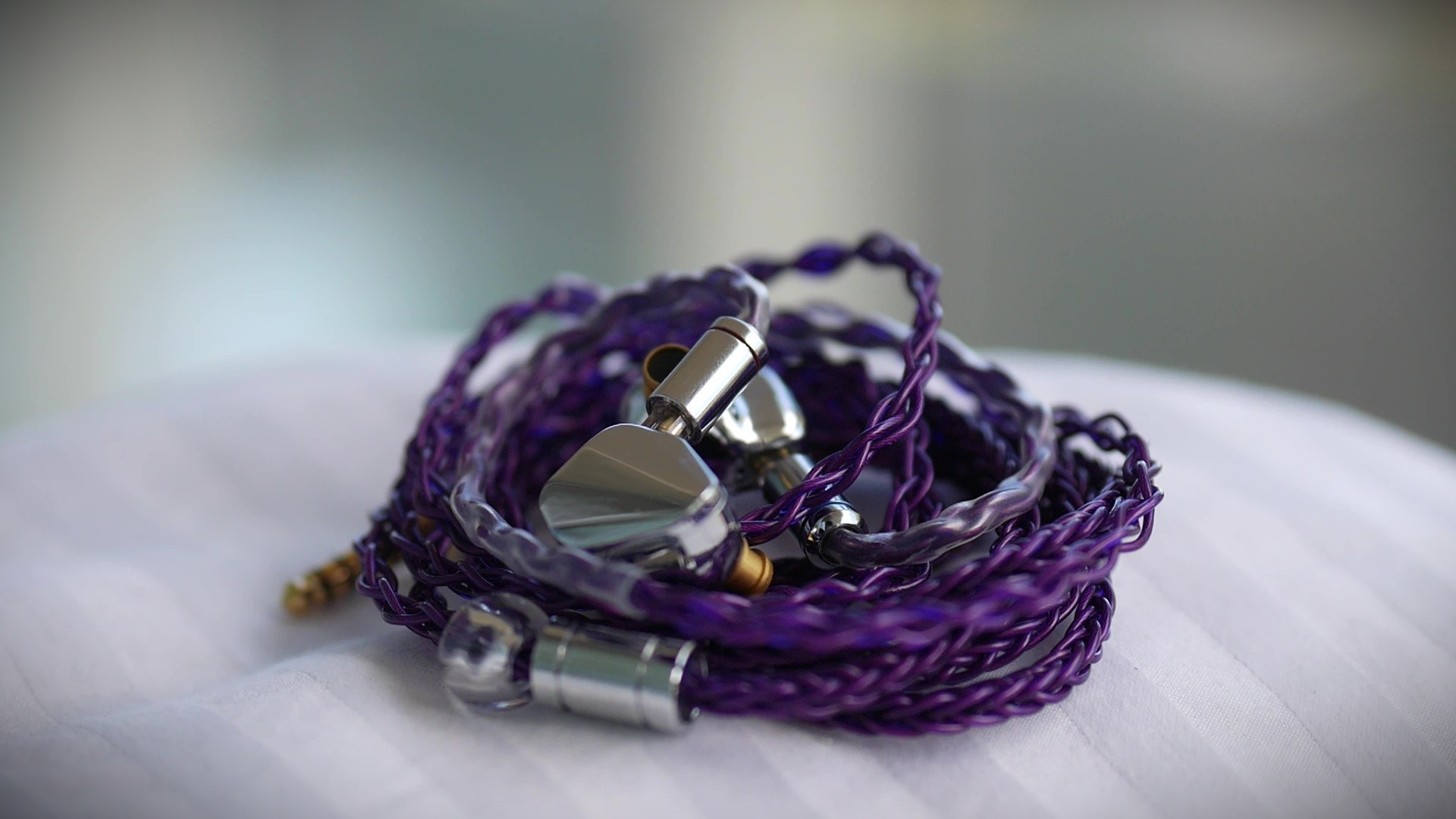
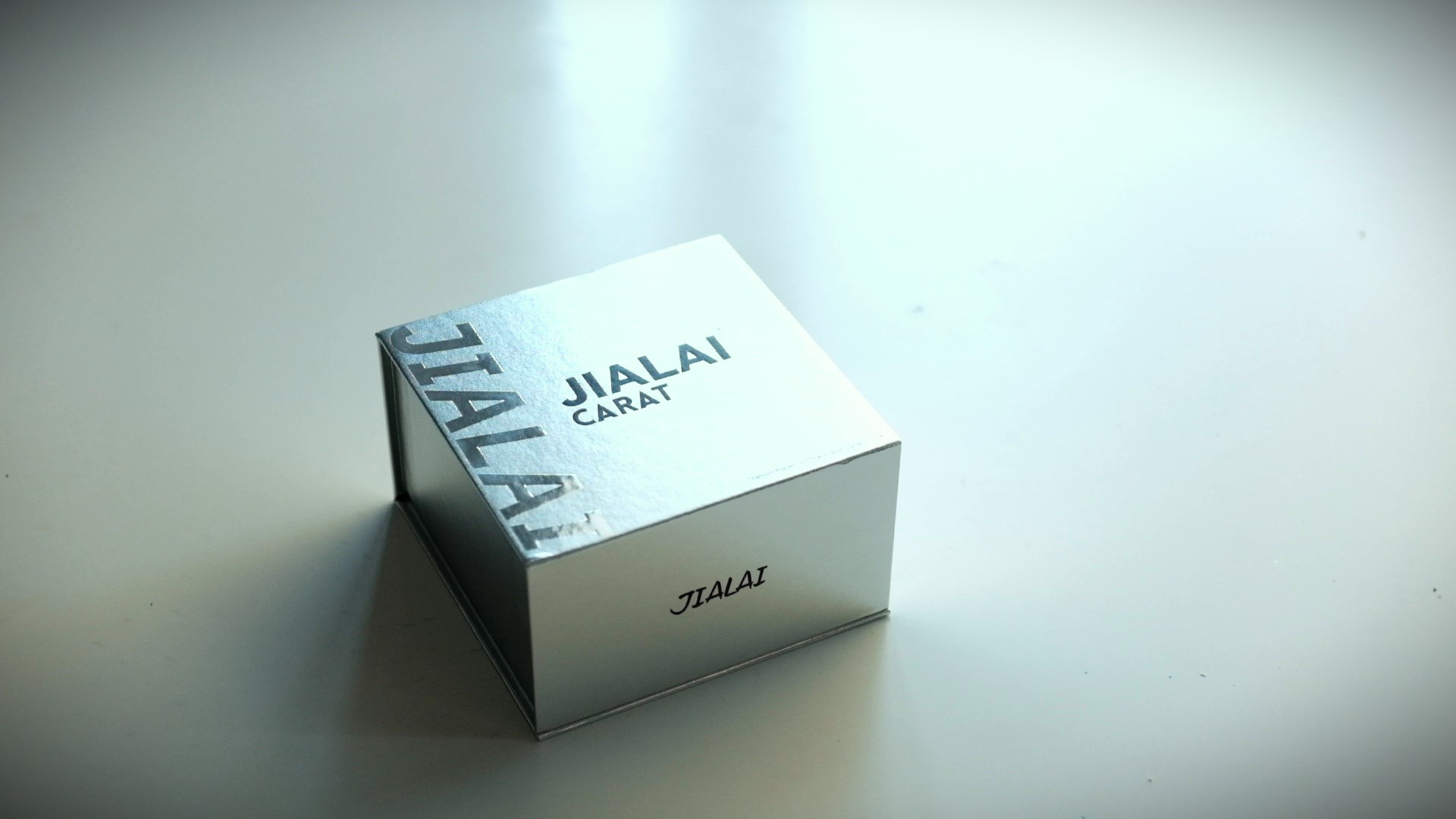
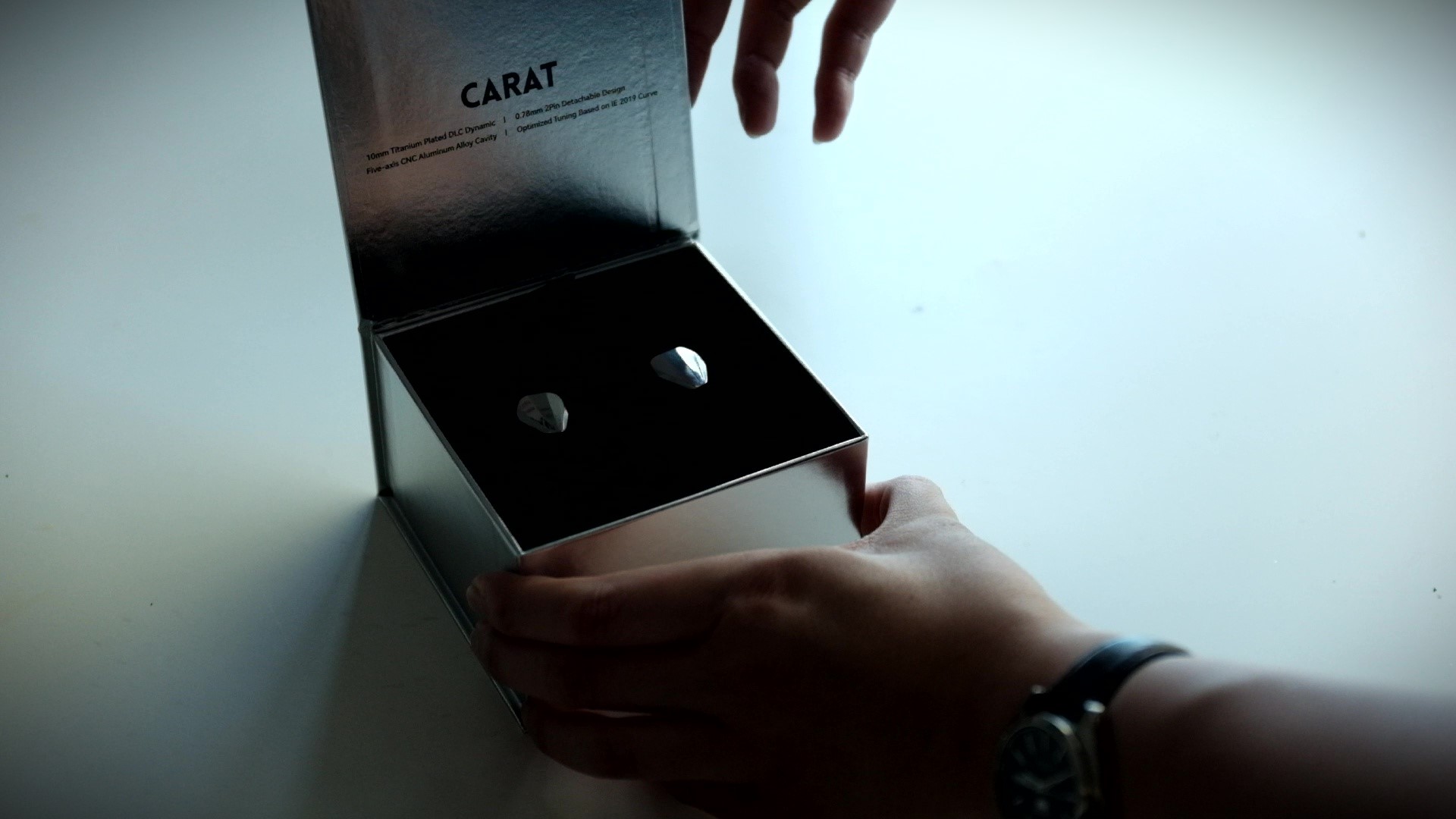
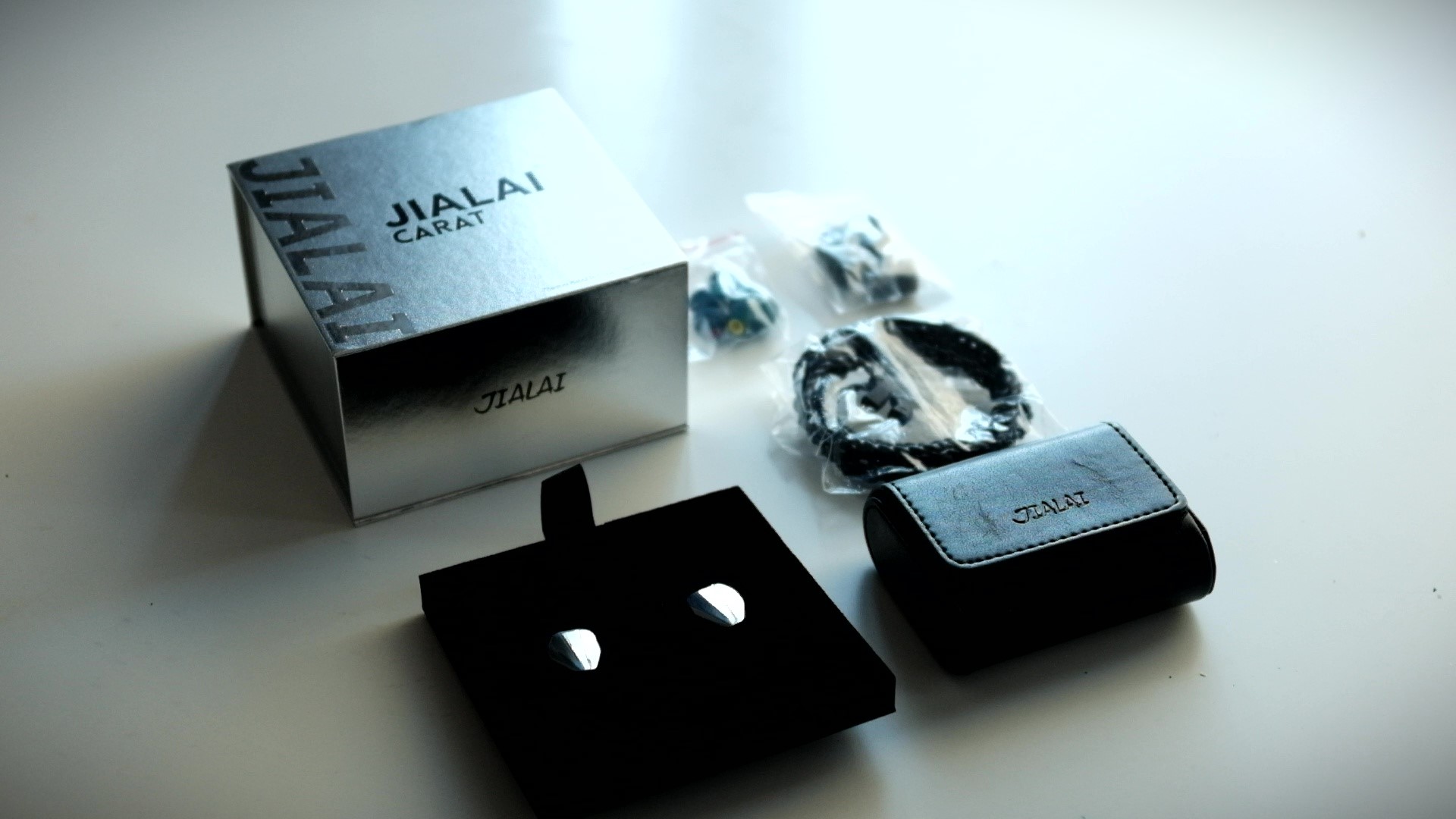

The accessory kit of Carat is complete and quite generous, considering the retail price. In the box, you would find three types of ear tips in three different sizes. I recommend that you play with all of them to find the best fit for your ears, as they might change the perceived sound quality quite noticeably. Other accessories include a standard 2-pin IEM cable with decent hardware. Unfortunately, the default cable has only 3.5mm termination. Finally, and surprisingly, Jialai also supplies a faux leather case to carry the IEM.
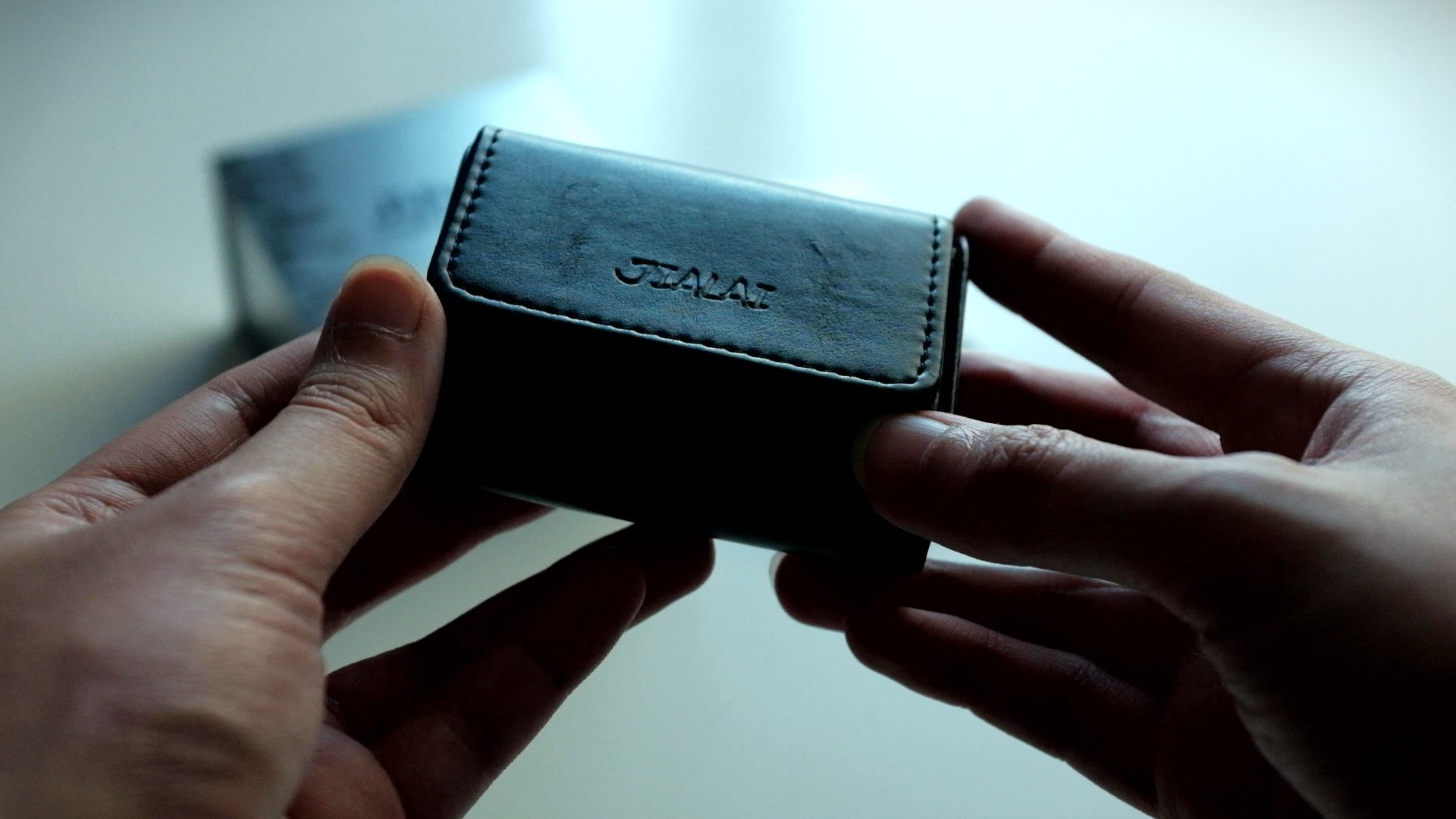
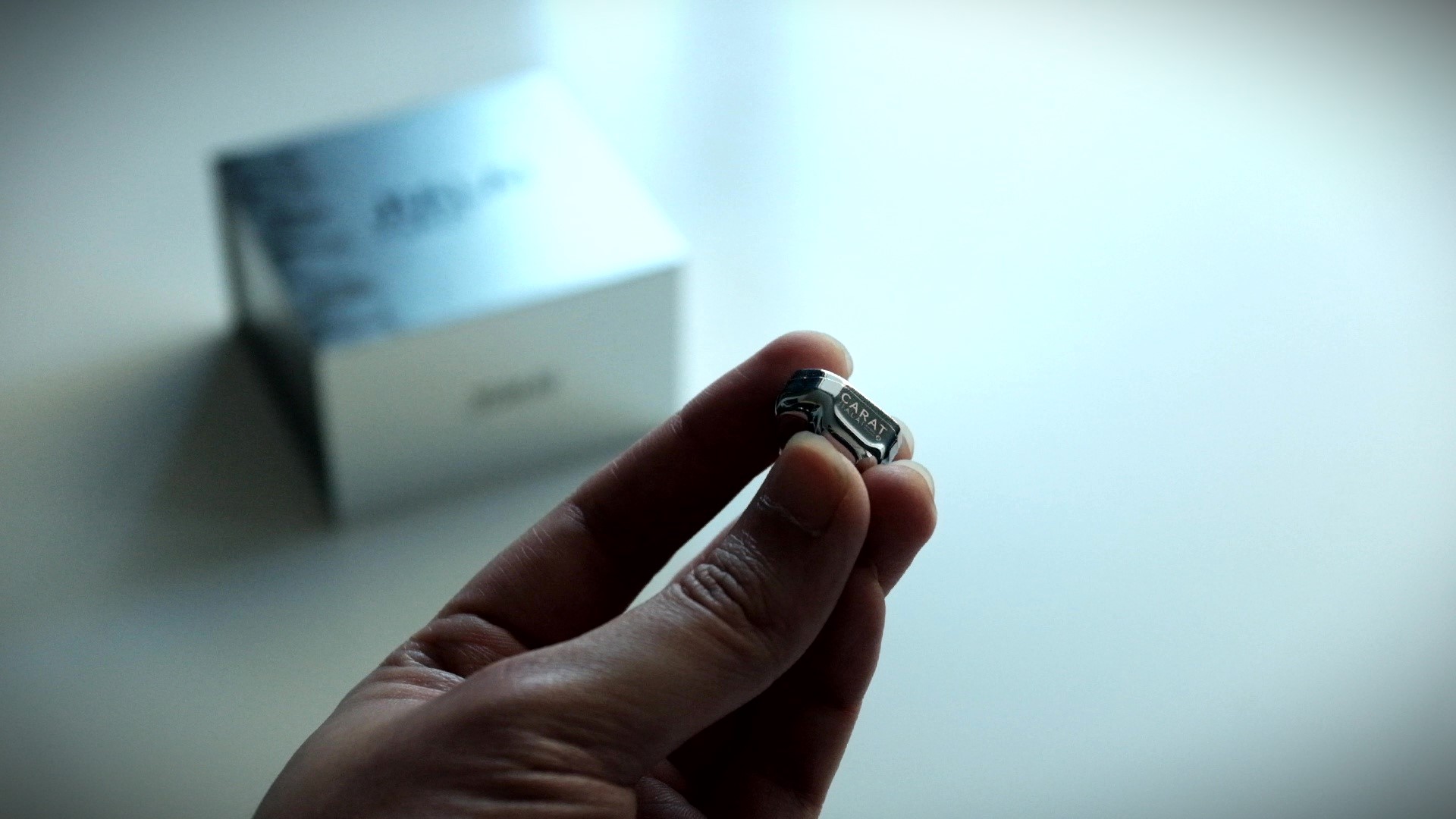

Because the earpieces are constructed from a metal alloy, they are not as light as other plastic IEMs, especially the hollow ones constructed from UV cured acrylic resins. Luckily, they are not as heavy as stainless steel IEMs like my FiiO FD5. As a result, I didn’t experience any discomfort due to the weight of the earpieces during my tests.
The ear pieces are well vented, thus I did not experience any pressure build up in my ear canal during my tests. On the other hand, the well vented design reduces the noise isolation of Carat. Though, I wouldn’t say it is less isolating than other single DD IEMs.

The nozzles of Carat are where I find some challenges. These IEMs have short nozzles with large lips at the top, a combination that makes ear tips pairing tricky. I recommend shorter ear tips with wide opening and sticky caps to pair with Carat. Shorter tips ensures that you can get the IEM to sit flush against the concha of your ears for a stable fit and smoother treble response. Because the ear tips do not sit deep in your ear canals, sticky caps are necessary to increase the stability. Wide opening is also recommended to avoid introducing unnecessary peaks to the treble response.
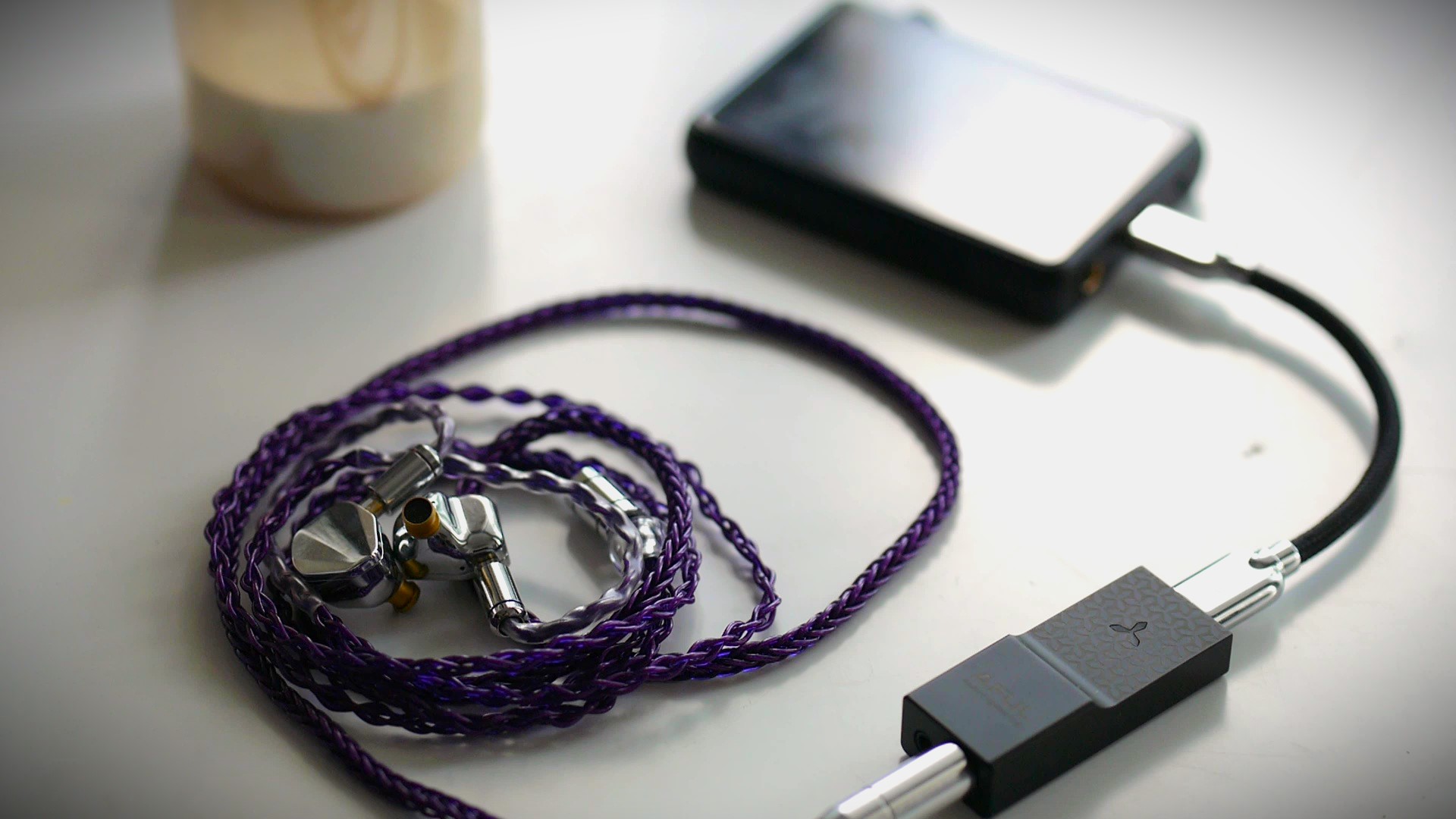
With a rated impedance of 32ohm and sensitivity of 108dB per mW (likely measured at 1kHz), Carat is a “moderately easy” IEM to drive. It means this IEM does not sound wrong or bad from sources with weaker amplification, but it does lose some magic.
For instance, when listening to the same song with Apple USB-C dongle and with iBasso DX300, it is quite noticeable that bass attacks are duller, the soundstage loses the “3D” sensation, and surprisingly I also hear more sibilance with the Apple dongle. These differences are more noticeable when music has more bass content, but less so with simple acoustic recordings with one voice and one instrument.
I would recommend sticking to Apple dongle or an entry level USB-C dongle such as FiiO KA11 for Carat. Though I do hear enough difference in the performance of Carat between the Apple dongle and higher-end DAC/amp, the relatively low price tag of Carat cannot justify an investment for a higher-end DAC/amp or music player, unless you have decided to make audio gear your long-term hobby.
The overall sound signature of Carat can be described as “V-shape” that leans toward the high frequencies, giving this IEM a strong sense of perceived clarity. At the same time, it has a slight emphasis in the lower midrange, which can reveal itself rather unexpectedly in some piano recordings.
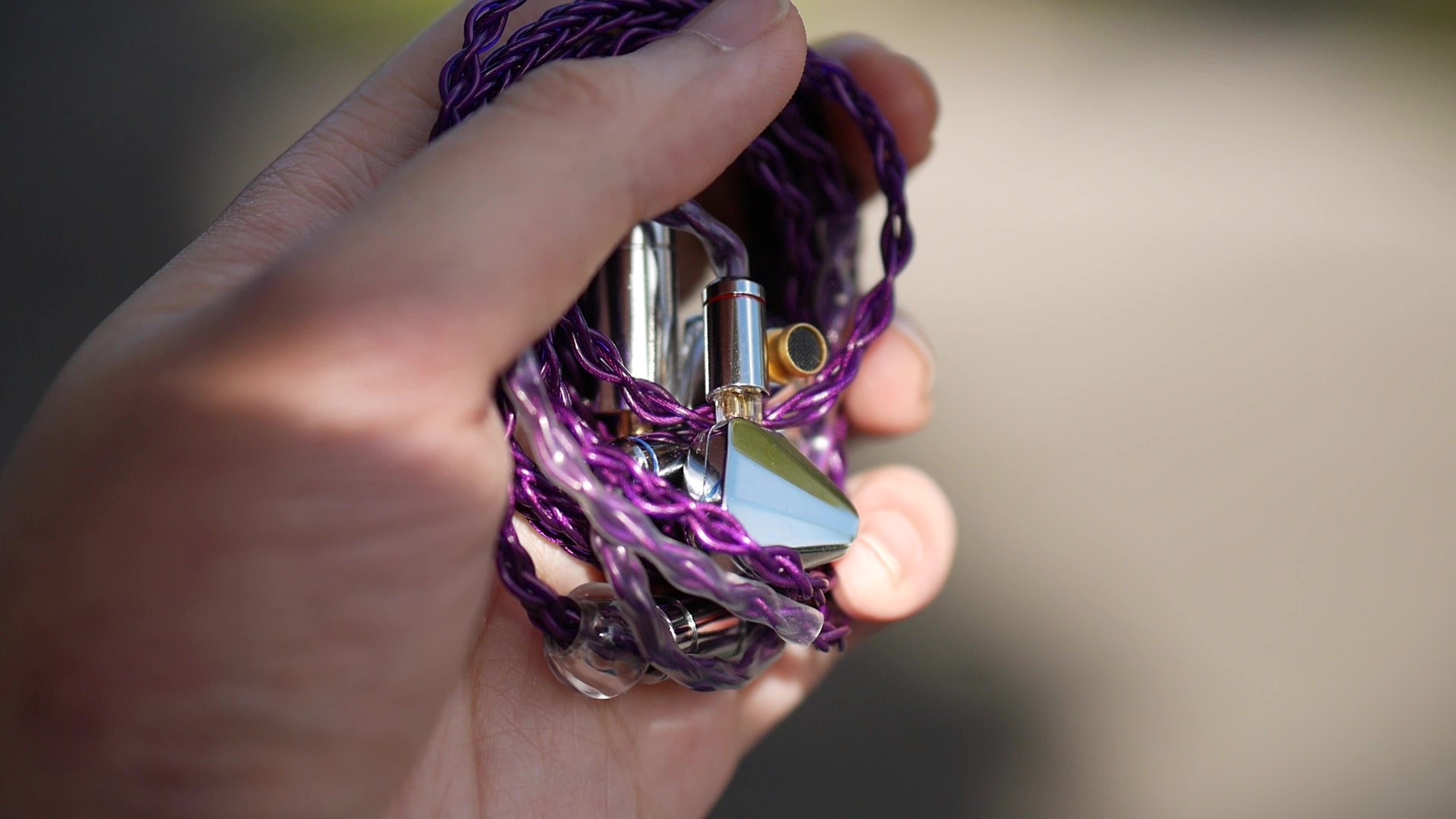
Vocal music:
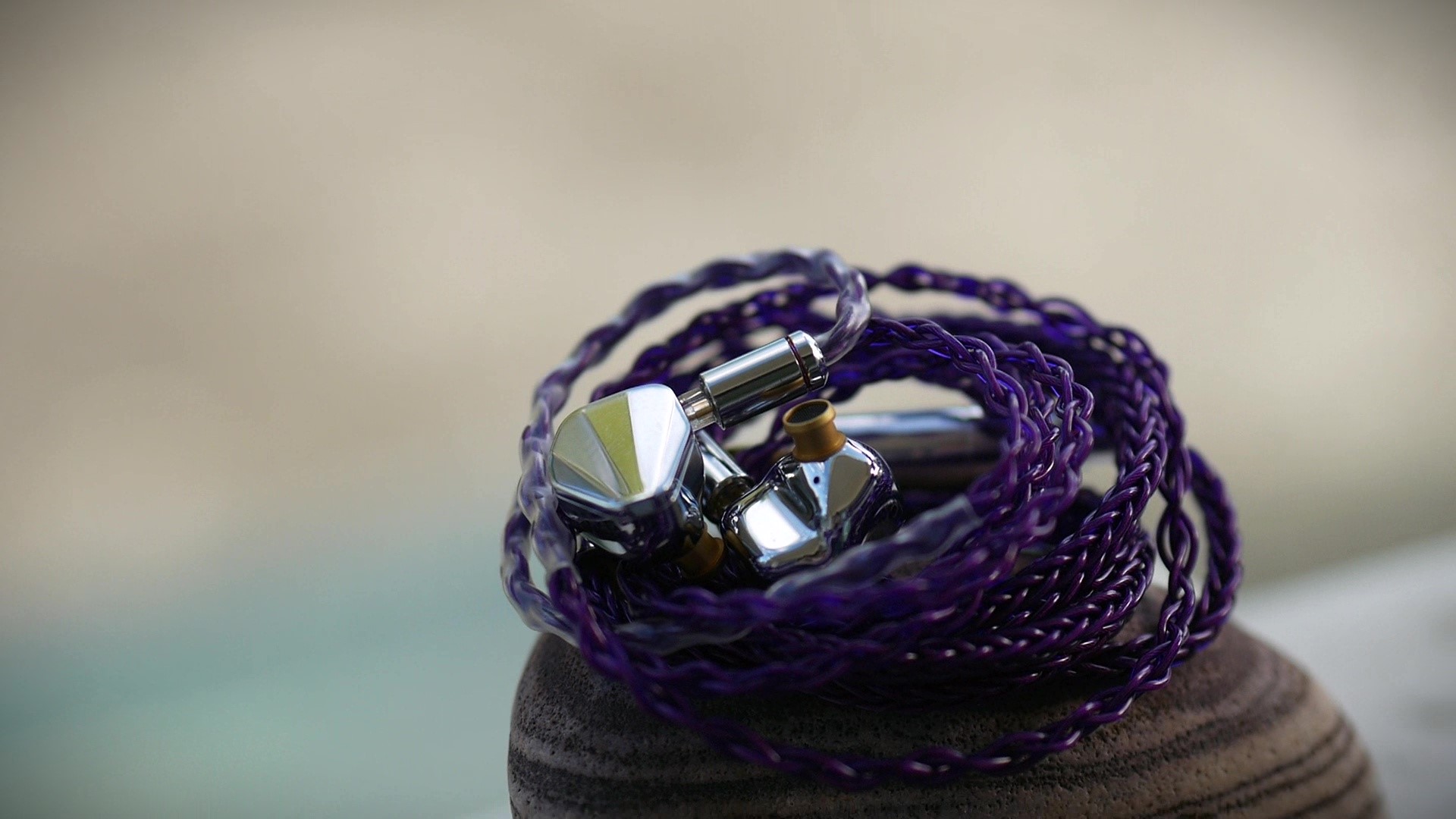
Rock:
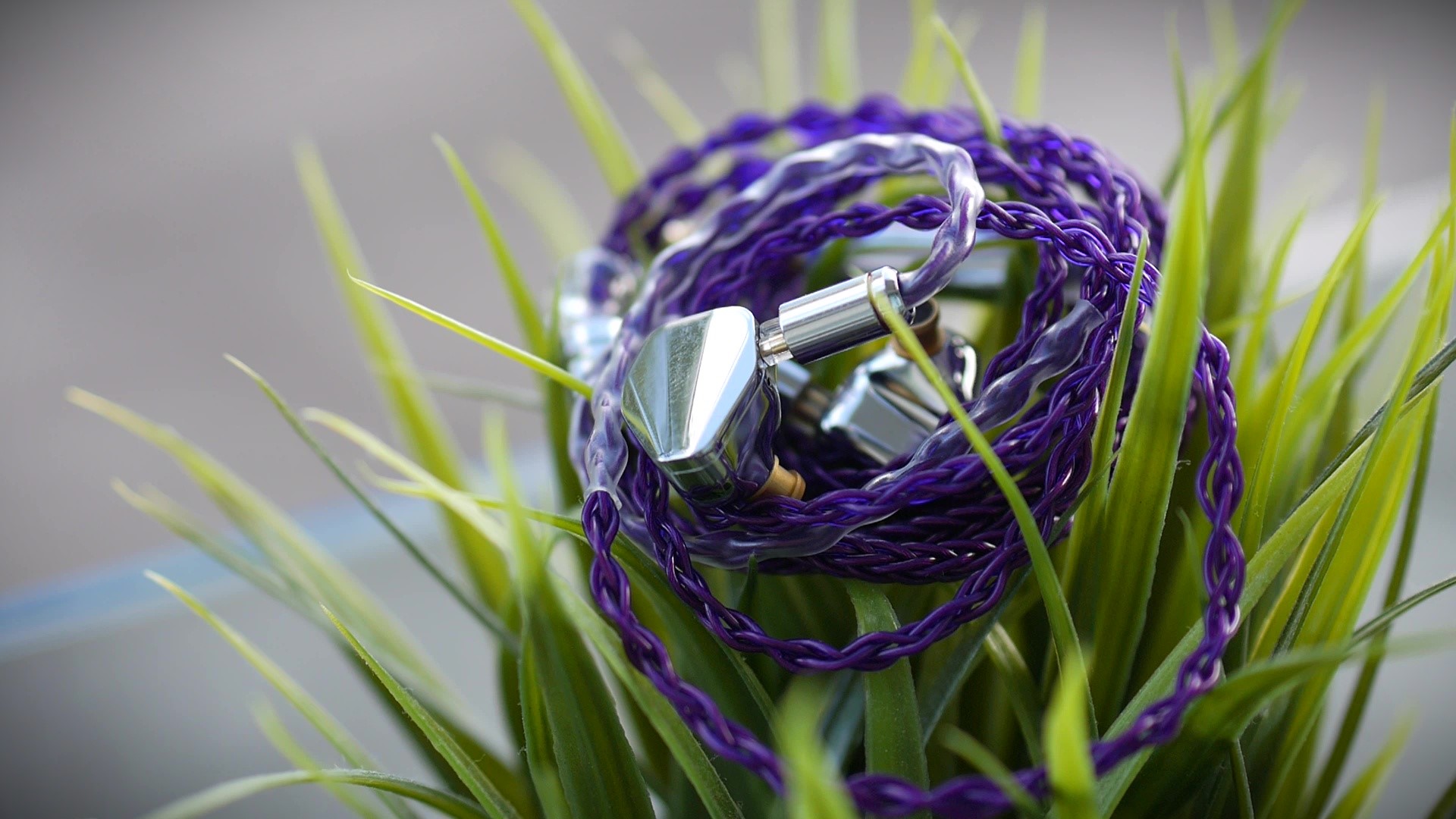
Classical:
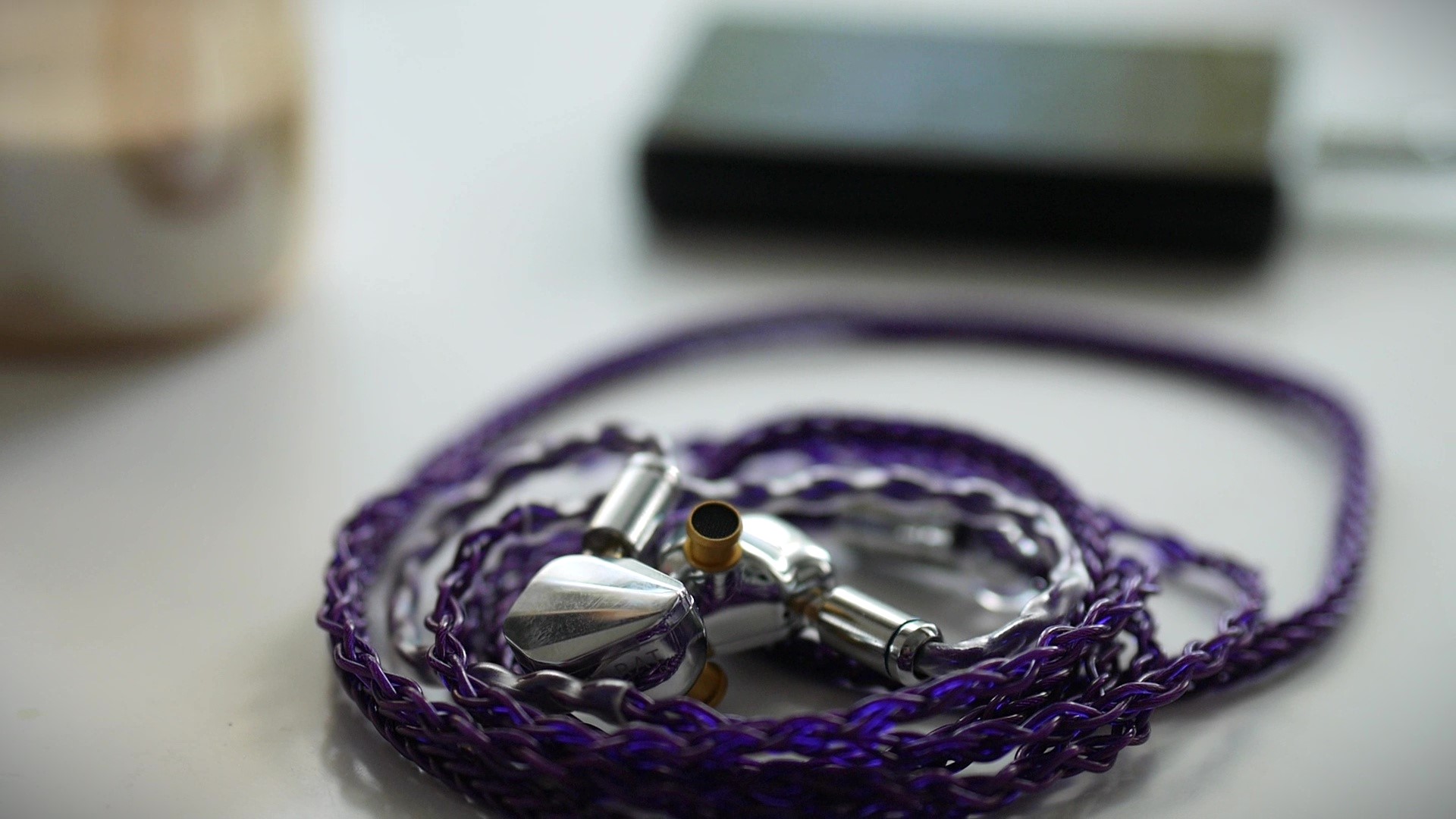
Orchestra and Cinematic Sound Tracks:
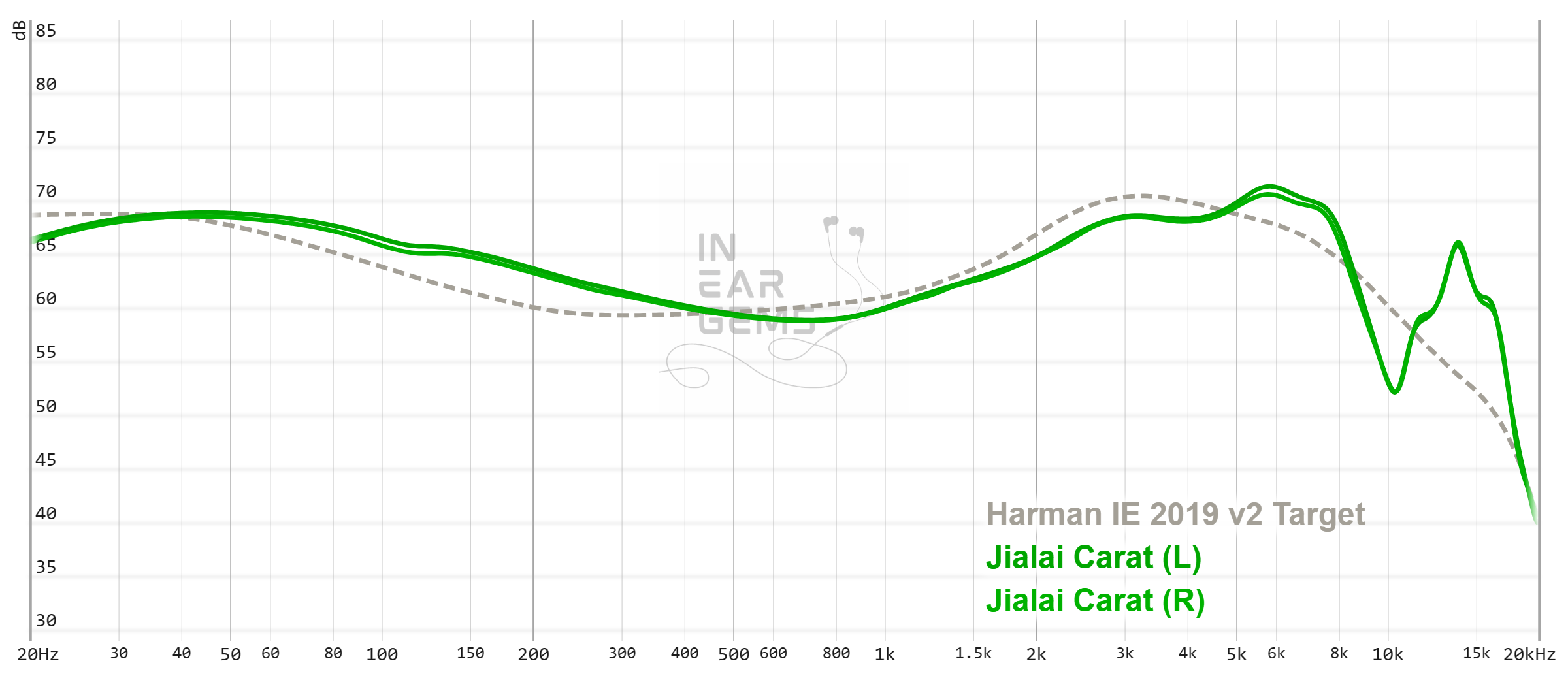
It is helpful to think of an IEM as a filter that highlights or subdues different parts of the incoming audio signal. This effect can be measured objectively by the squiggly lines above, called Frequency Response (FR) graphs, which measure how loud an IEM is at different frequencies from 20Hz (bass) to 20kHz (upper treble). Subjectivity is how your ears and brain interpret the effect of that filter on your music and decide whether it is “enjoyable.” There are some “rules of thumb” when it comes to tonality, but most interesting IEMs usually bend the rules masterfully.
Jialai claims that Carat has been tuned according to Harman in-ear 2019 target, with flourishes based on the experience of their engineering team. To me, I found that the adjustments push Carat toward a V-shaped even more so than a “full Harman” IEM.
Midrange (250Hz - 5kHz): The midrange of Carat follows the Harman target generally from 800Hz to around 4kHz. This adherence explains the overall sense of clarity that Carat exhibits in the midrange region. However, it has a substantial deviation in the lower midrange. The additional energy in this region helps Carat avoid the thin and somewhat disjointed midrange that plagues many full Harman IEM. However, I think that Jialai puts a few dB too much energy in this region, leading to the strange presentation of piano that I described previously.
Bass (20Hz - 250Hz): The bass boost of Carat is roughly balanced against its upper midrange, which explains the balanced presentation that I noted in the subjective impressions. The ratio between midbass (the “punch” sensation) and the subbass (the “rumble” sensation) is higher than the ratio prescribed by the target. This tuning choice partially explains the presence and texture of bass instruments.
Highs (5kHz - 20kHz): The treble region is where Carat exhibits the most deviation from the target. In particular, Carat has a strong boost in the 6-8kHz, the region where Harman target de-emphasizes. This treble boost lends Carat’s note attacks their (perceived) crispness and clarity. Fortunately, the treble was not unpleasant despite this boost. However, if you are sensitive to treble and if you use an Apple dongle, it’s possible that this boost can be difficult on the ears with some tracks.

Resolution is a fascinating subject due to the difficulty of pinning down what it really is. To me, “resolution” can be broken down into three components: (1) Sharpness, incisiveness, or “definition” of note attacks (see the figure above). (2) The separation of instruments and vocals, especially when they overlap on the soundstage. (3) The texture and details in the decay side of the notes. The first two give music clarity and make it easy to track individual elements of a mix. The last provides music details and nuances. Smooth and well extended treble response plays a crucial role.
Carat has a strong sense of clarity thanks to the tuning and, likely, the quality of the dynamic driver. In direct comparison, I found Carat to be noticeably crisper with more defined musical notes than the venerable Moondrop Aria (2021 version).
The instrument separation is good, though not great. Whilst Carat does a good job in sparse recording, its ability to place boundaries between instruments gets noticeably weaker in complex and busy sections of recordings, making it harder to follow individual elements of a mix. The detail retrieval ability of Carat is also adequate for casual listening, but does not stands up to focused listening sessions.
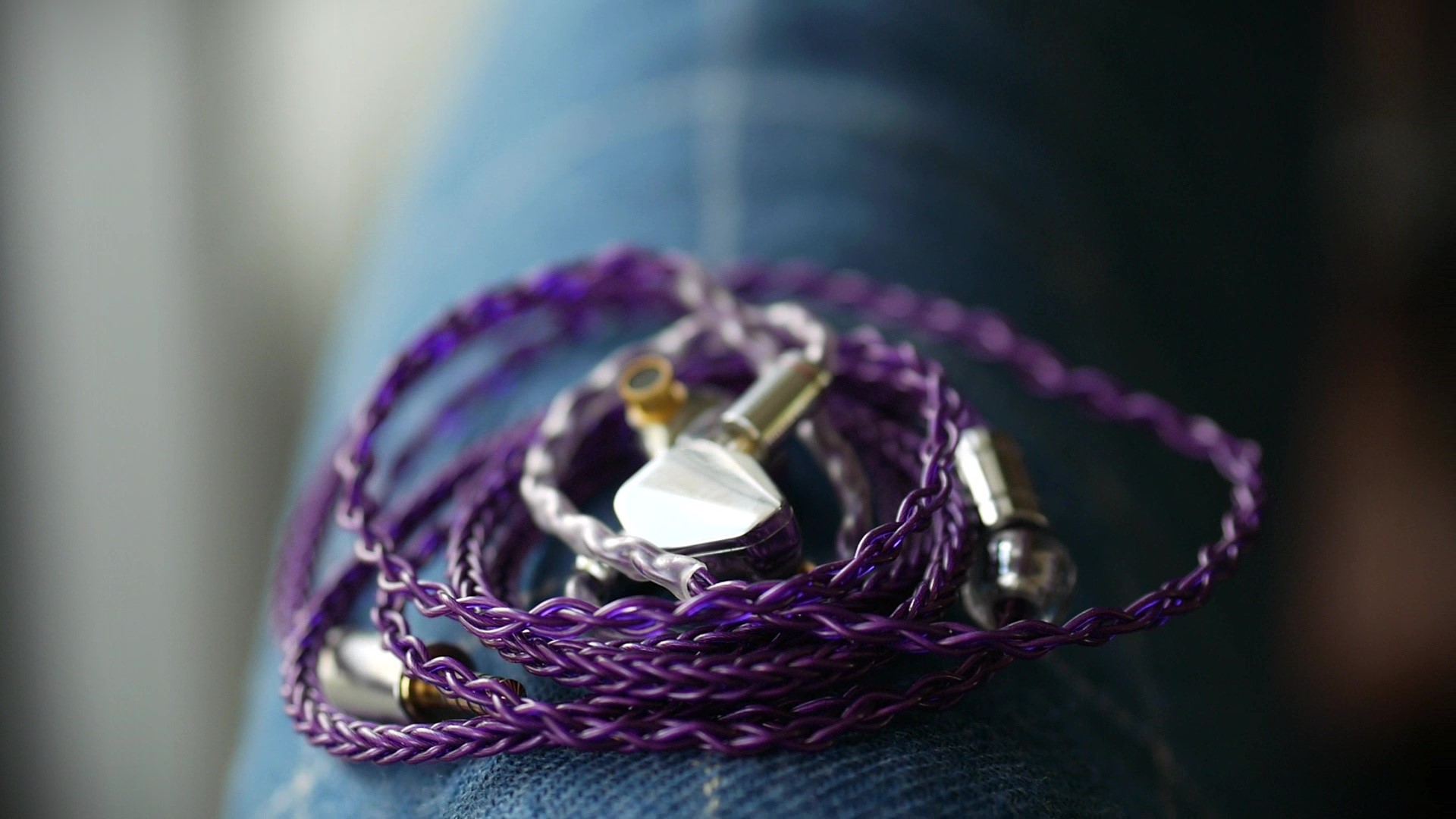
Still, for the intended user base and price bracket, I suspect that strong sense of clarity of Carat would make up for the instrument separation and detail retrieval.

Stereo imaging or “soundstage” is a psychoacoustic illusion that different recording elements appear at various locations inside and around your head. Your brain creates based on the cues in the recording, which are enhanced or diminushed by your IEMs, your DAC, and your amplifier. Some IEMs present a wide but flat soundstage. Some present a “3D” soundstage with layering, depth, and height. In rare cases, with some specific songs, some IEMs can trick you into thinking that the sound comes from the environment (a.k.a., “holographic”)
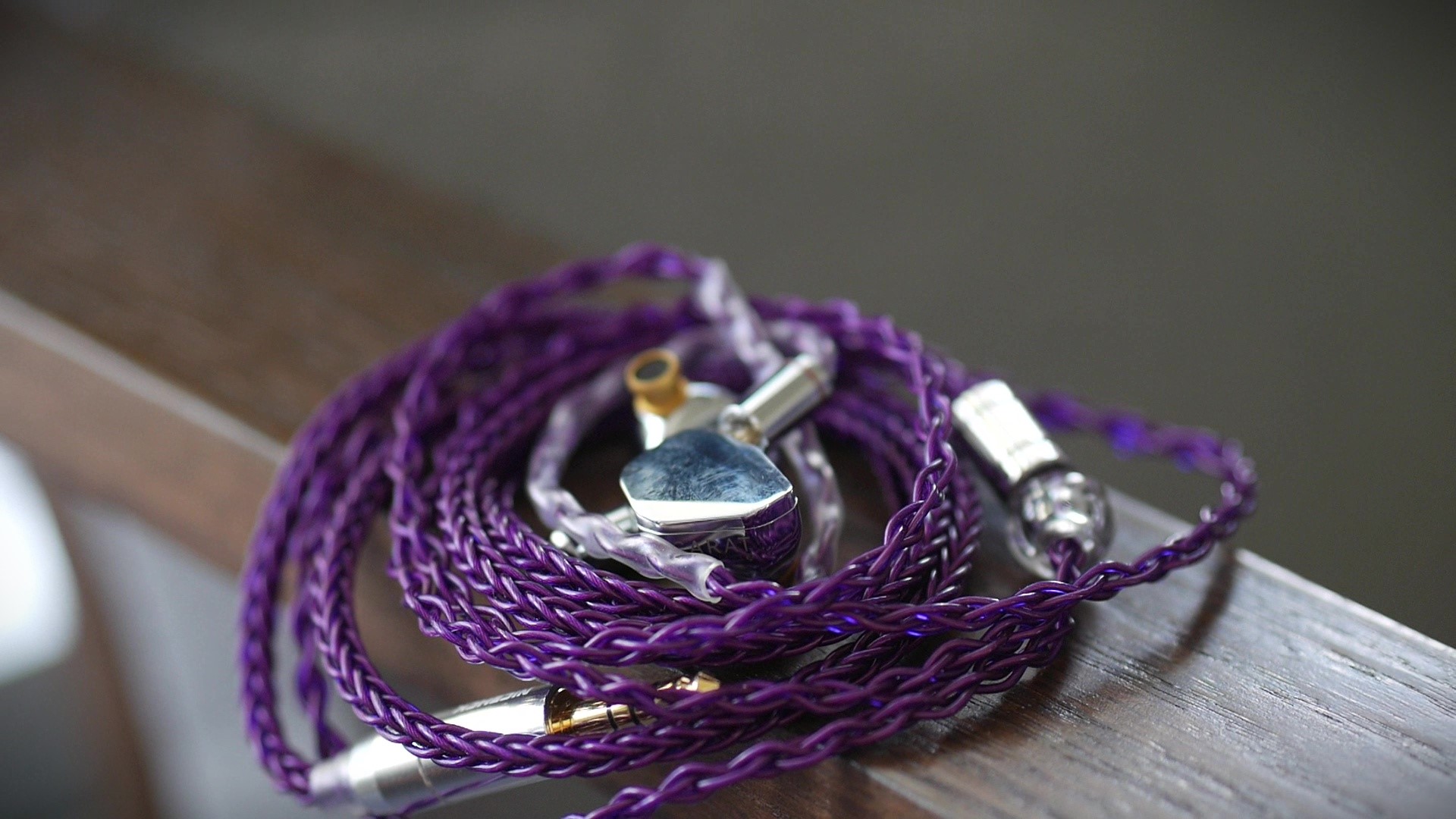
The stage of Carat can feel quite open and spacious. If a track is mixed with interesting instrument placement, this IEM can convey a nice 3D illusion, though it does suffer when facing denser and more complex recordings. Moreover, whether it can achieve a good soundstage presentation depends a great deal on the DAC and amp you use to drive it. As I mentioned previously in the pairing session, I found the stage and imaging of Carat to be unremarkable with the Apple dongle.
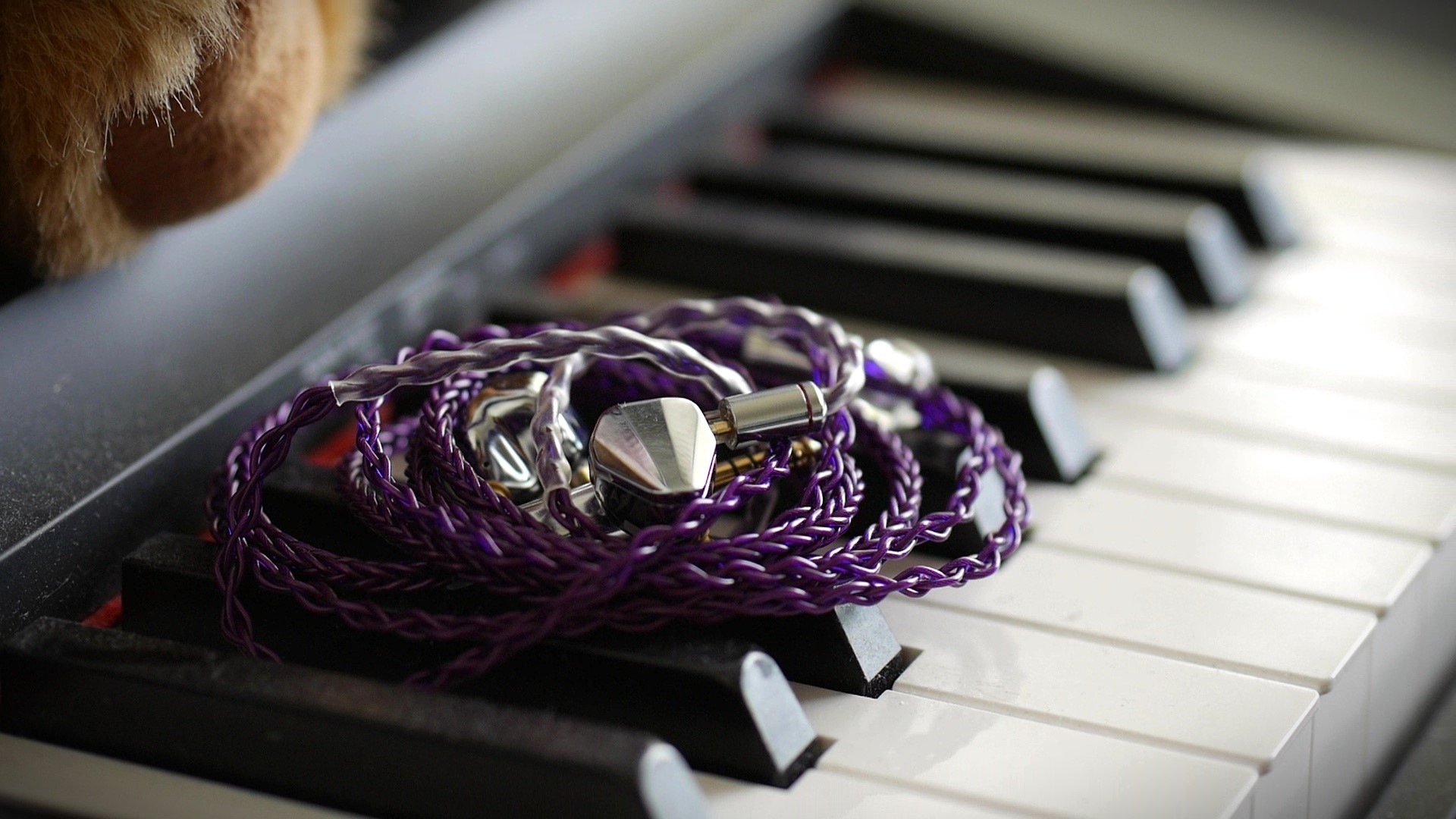
What I like about this IEM:
Absolute Sonic Quality Rating: 3/5 - Good (Tonality 3/5; Resolution 2.5/5; Bass 3/5; Spatial 3.5/5)
Bias Score: 3/5 - I’m okay with this IEM.

Updated: March 17, 2024

Forewords
- What I look for in an IEM is immersion. I want to feel the orchestra around me, track individual instruments, and hear all of their textures and details. I’m not picky about tonality, as long as it is not make the orchestra, violin, cellos, and pianos sound wrong. However, when an IEM does tonality especially well, I will mention.
- I rate IEMs within with a consistent scale from 1 (Poor) to 3 (Good) to 5 (Outstanding). An overall ranking of 3/5 or above is considered positive.
- Ranking list and measurement database are on my IEM review blog.
- Terms used in my reviews are consistent with the glossary by Headphonesty
- This review is based on a review sample from NiceHck (Thank you!). I have no affiliation with or financial interest in NiceHck and Jialai.
- The unit retails for $70 at the time this review was published. Unaffiliated links: NiceHck store
General Information
Carat is equipped with a single 10mm dynamic driver with titanium-plated DLC diaphragm. The drivers are encased in aluminium alloy shells. It is tuned according to the Harman In-Ear target but with some significant variations, which we will discuss further in the frequency response analysis section of this review. Similarly to most IEMs on the market, Carat is equipped with 2-pin, 0.78mm sockets to support interchangeable cables.



The accessory kit of Carat is complete and quite generous, considering the retail price. In the box, you would find three types of ear tips in three different sizes. I recommend that you play with all of them to find the best fit for your ears, as they might change the perceived sound quality quite noticeably. Other accessories include a standard 2-pin IEM cable with decent hardware. Unfortunately, the default cable has only 3.5mm termination. Finally, and surprisingly, Jialai also supplies a faux leather case to carry the IEM.

Physical Aspects
The earpieces of Carat are machined from an aluminium alloy and polished nearly to a mirror finish. I said nearly because if you inspect the faceplates of the IEM closely, you would find that the surfaces have slight ripples rather than being perfectly flat. Another issue, which is to be expected from mirror-like surfaces, is that Carat earpieces are fingerprint magnets. If you want to keep the IEMs beautiful all the time, you should keep a microfiber cloth nearby.

Because the earpieces are constructed from a metal alloy, they are not as light as other plastic IEMs, especially the hollow ones constructed from UV cured acrylic resins. Luckily, they are not as heavy as stainless steel IEMs like my FiiO FD5. As a result, I didn’t experience any discomfort due to the weight of the earpieces during my tests.
The ear pieces are well vented, thus I did not experience any pressure build up in my ear canal during my tests. On the other hand, the well vented design reduces the noise isolation of Carat. Though, I wouldn’t say it is less isolating than other single DD IEMs.

The nozzles of Carat are where I find some challenges. These IEMs have short nozzles with large lips at the top, a combination that makes ear tips pairing tricky. I recommend shorter ear tips with wide opening and sticky caps to pair with Carat. Shorter tips ensures that you can get the IEM to sit flush against the concha of your ears for a stable fit and smoother treble response. Because the ear tips do not sit deep in your ear canals, sticky caps are necessary to increase the stability. Wide opening is also recommended to avoid introducing unnecessary peaks to the treble response.
Driveability and Pairing

With a rated impedance of 32ohm and sensitivity of 108dB per mW (likely measured at 1kHz), Carat is a “moderately easy” IEM to drive. It means this IEM does not sound wrong or bad from sources with weaker amplification, but it does lose some magic.
For instance, when listening to the same song with Apple USB-C dongle and with iBasso DX300, it is quite noticeable that bass attacks are duller, the soundstage loses the “3D” sensation, and surprisingly I also hear more sibilance with the Apple dongle. These differences are more noticeable when music has more bass content, but less so with simple acoustic recordings with one voice and one instrument.
I would recommend sticking to Apple dongle or an entry level USB-C dongle such as FiiO KA11 for Carat. Though I do hear enough difference in the performance of Carat between the Apple dongle and higher-end DAC/amp, the relatively low price tag of Carat cannot justify an investment for a higher-end DAC/amp or music player, unless you have decided to make audio gear your long-term hobby.
Subjective Experience
Testing setup: iBasso DX300 (stock player app) -> stock cable (4.4mm) -> IEM -> Medium wide bore ear tipsThe overall sound signature of Carat can be described as “V-shape” that leans toward the high frequencies, giving this IEM a strong sense of perceived clarity. At the same time, it has a slight emphasis in the lower midrange, which can reveal itself rather unexpectedly in some piano recordings.

Vocal music:
- Pentatonix - Can’t help falling in love: All voices have natural timbre and good balance in loudness. I hear great clarity across all voices of Pentatonix members without any shrill or sibilance, unless I use the Apple dongle. But even when I do use Apple dongle, the sibilance was not offensive. Despite the great perceived clarity, I found that the voices are not easily separated and followed in denser sections of the song.
- John Denver - Leaving on a jet plane: The voice of John Denver sounds mostly correct with great clarity. I do find the voice to be ever so slightly nasally, possibly due to a dB or two too low around 1kHz to 2kHz. However, I’m nitpicking here. In the treble region, I didn’t hear any sibilance even though this IEM does not hold back on the loudness of chimes and the fatiguing triangle on the right channel. Likely thanks to the treble, I can discern a reasonable amount of micro details.
- Ed Sheeran - Shivers: This song pushes the limit of my comfort with the shrill in the chorus section. Carat does noting to mitigate this shrill, though at least it does not intensify it. Interestingly, I found that the voice of Ed Sheeran still has a resemblance of balance and richness in this bright recording. The Carat also managed to convey a good sense of space with this track. For example, the repeated synth pattern throughout the song was able to “break the headstage” to convey the illusion that they come from a distant at the front-left direction.

Rock:
- Polyphia - Playing God: Carat reproduces this complex math rock piece quite well with a snappy, dynamic, and clear presentation. I hear the guitars spread out across a soundstage that feels quite open. Cymbals and hats are prominent in the mix but, surprisingly, not shrill or harsh. The bass quantity is not overwhelming but enough to make the bass guitar audible. The kick drums have a good sense of dynamic as Carat can reproduce the volume swings at the attack of bass notes quite well.
- MAN WITH A MISSION - Raise Your Flag: I hear a neutral-bright presentation with this track using Carat. The IEM conveys good clarity and a sense of openness to the track. However, instruments and voices in the upper mids and highs are not well separated in busy sections of the track, suggesting the limitation of the “raw resolution” of the IEMs themselves. In terms of the bass frequencies, Carat again provides good bass quality with dynamic and texture, but I find the quantity to be insufficient to convey the energy of this track.

Classical:
- J.S. Bach: Goldberg Variations, BWV 988 - Aria · Julian Rachlin · Nobuko Imai · Mischa Maisky: I hear a natural timbre and good tonal balance across all three instruments. In particular, I found the cello to have authority and texture. The positioning and separation of three instruments are also precise and stable enough, though I would note that I hear less depth contrast (i.e., near to far placement) than what I expected. In general, there is no much to complain here.
- Lang Lang - Bach: Goldberg Variations, BWV 988: Aria: Coming from the strong tonal performance so far, I was shocked by how unnatural Carat sounds with this track. In particular, I hear an imbalance towards the left hand notes of the piano, making them boomy and disturbing the positioning of the piano in the mix. It feels as if I’m putting my head against the left side of the piano, putting the bass notes upfront, the midrange a bit further, and treble all the way away. This strange presentation does not exist even with “bass cannons” like FatFreq Maestro Mini, indicating that the problem comes from the lower midrange and upper bass, rather than the bass itself.

Orchestra and Cinematic Sound Tracks:
- A Way of Life - The Last Samurai: Carat creates a sufficiently open and clear presentation. However, the lack of of treble extension (“air”) prevents this IEM from fully reproducing the foggy, misty ambiance of this track. In direct comparisons against some of my benchmark IEMs, I found that Carat does not separate the background sufficiently from the foreground instruments of the mix to create the illusion.
- Final Mission - Quantum Burst: Carat conveys a good sense of space and openness with this track. The bass feels snappy and possesses good texture, lending good energy to this energetic track.
Frequency Response Analysis
Frequency response of Jialai Carat against the Harman in-ear target. Measurements were done with an IEC-711-compliant coupler and might only be compared with other measurements from this same coupler. Visit my graph database for more comparisons.
It is helpful to think of an IEM as a filter that highlights or subdues different parts of the incoming audio signal. This effect can be measured objectively by the squiggly lines above, called Frequency Response (FR) graphs, which measure how loud an IEM is at different frequencies from 20Hz (bass) to 20kHz (upper treble). Subjectivity is how your ears and brain interpret the effect of that filter on your music and decide whether it is “enjoyable.” There are some “rules of thumb” when it comes to tonality, but most interesting IEMs usually bend the rules masterfully.
Jialai claims that Carat has been tuned according to Harman in-ear 2019 target, with flourishes based on the experience of their engineering team. To me, I found that the adjustments push Carat toward a V-shaped even more so than a “full Harman” IEM.
Midrange (250Hz - 5kHz): The midrange of Carat follows the Harman target generally from 800Hz to around 4kHz. This adherence explains the overall sense of clarity that Carat exhibits in the midrange region. However, it has a substantial deviation in the lower midrange. The additional energy in this region helps Carat avoid the thin and somewhat disjointed midrange that plagues many full Harman IEM. However, I think that Jialai puts a few dB too much energy in this region, leading to the strange presentation of piano that I described previously.
Bass (20Hz - 250Hz): The bass boost of Carat is roughly balanced against its upper midrange, which explains the balanced presentation that I noted in the subjective impressions. The ratio between midbass (the “punch” sensation) and the subbass (the “rumble” sensation) is higher than the ratio prescribed by the target. This tuning choice partially explains the presence and texture of bass instruments.
Highs (5kHz - 20kHz): The treble region is where Carat exhibits the most deviation from the target. In particular, Carat has a strong boost in the 6-8kHz, the region where Harman target de-emphasizes. This treble boost lends Carat’s note attacks their (perceived) crispness and clarity. Fortunately, the treble was not unpleasant despite this boost. However, if you are sensitive to treble and if you use an Apple dongle, it’s possible that this boost can be difficult on the ears with some tracks.
Resolution

Resolution is a fascinating subject due to the difficulty of pinning down what it really is. To me, “resolution” can be broken down into three components: (1) Sharpness, incisiveness, or “definition” of note attacks (see the figure above). (2) The separation of instruments and vocals, especially when they overlap on the soundstage. (3) The texture and details in the decay side of the notes. The first two give music clarity and make it easy to track individual elements of a mix. The last provides music details and nuances. Smooth and well extended treble response plays a crucial role.
Carat has a strong sense of clarity thanks to the tuning and, likely, the quality of the dynamic driver. In direct comparison, I found Carat to be noticeably crisper with more defined musical notes than the venerable Moondrop Aria (2021 version).
The instrument separation is good, though not great. Whilst Carat does a good job in sparse recording, its ability to place boundaries between instruments gets noticeably weaker in complex and busy sections of recordings, making it harder to follow individual elements of a mix. The detail retrieval ability of Carat is also adequate for casual listening, but does not stands up to focused listening sessions.

Still, for the intended user base and price bracket, I suspect that strong sense of clarity of Carat would make up for the instrument separation and detail retrieval.
Soundstage Imaging

Stereo imaging or “soundstage” is a psychoacoustic illusion that different recording elements appear at various locations inside and around your head. Your brain creates based on the cues in the recording, which are enhanced or diminushed by your IEMs, your DAC, and your amplifier. Some IEMs present a wide but flat soundstage. Some present a “3D” soundstage with layering, depth, and height. In rare cases, with some specific songs, some IEMs can trick you into thinking that the sound comes from the environment (a.k.a., “holographic”)

The stage of Carat can feel quite open and spacious. If a track is mixed with interesting instrument placement, this IEM can convey a nice 3D illusion, though it does suffer when facing denser and more complex recordings. Moreover, whether it can achieve a good soundstage presentation depends a great deal on the DAC and amp you use to drive it. As I mentioned previously in the pairing session, I found the stage and imaging of Carat to be unremarkable with the Apple dongle.
Rating and Conclusion

What I like about this IEM:
- Clean, clear, and open sonic presentation
- Strong sense of clarity but rarely get shrill, harsh, or sibilant
- Bass is controlled with good dynamic and texture
- Can convey a 3D sound scape with the right track
- Good build quality
- Complex set of quality accessories
- Tonality can be unbalanced with some recording
- Short nozzles make ear tips pairing tricky
- Dependent on the choice of DAC and amp
- Fierce competition
Absolute Sonic Quality Rating: 3/5 - Good (Tonality 3/5; Resolution 2.5/5; Bass 3/5; Spatial 3.5/5)
Bias Score: 3/5 - I’m okay with this IEM.

Updated: March 17, 2024

